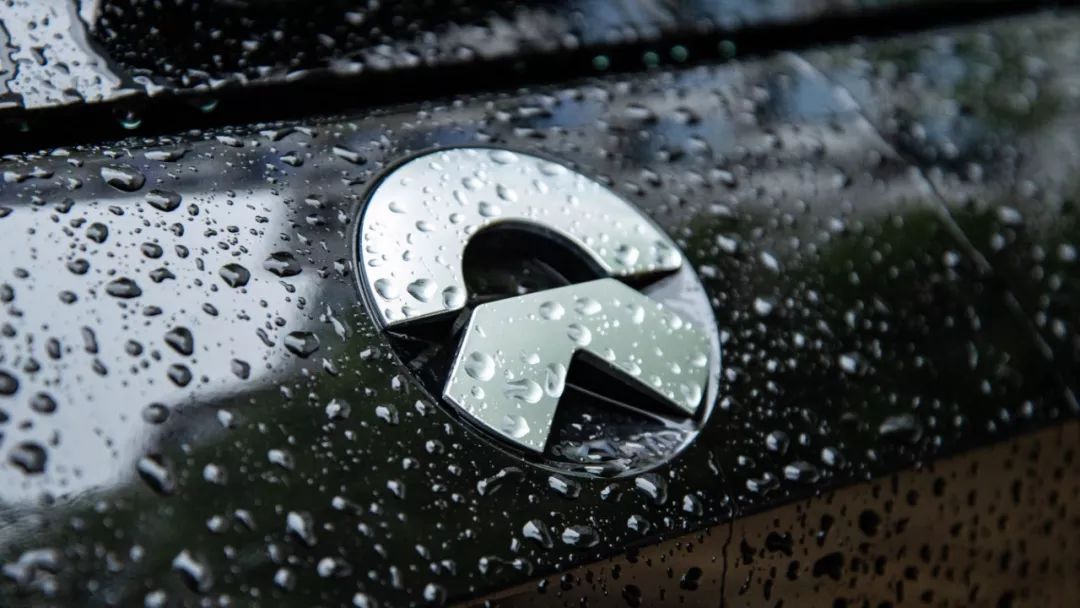NIO ES8, officially released in December 2017 and delivered in June 2018, has delivered a total of 17,550 ES8 models as of May this year. Is this considered successful for a new automaker?
From the perspectives of sales and brand, compared with other new automaker brands that debuted at the same time, NIO is successful.
However, NIO has been in the midst of public opinion since its delivery, receiving both praise and criticism. This divide is particularly evident between car owners and non-car owners. What is the problem exactly? It is difficult for us to take a bystander’s view of the NIO brand and the ES8 car, so we conducted a long-term experience of the ES8.
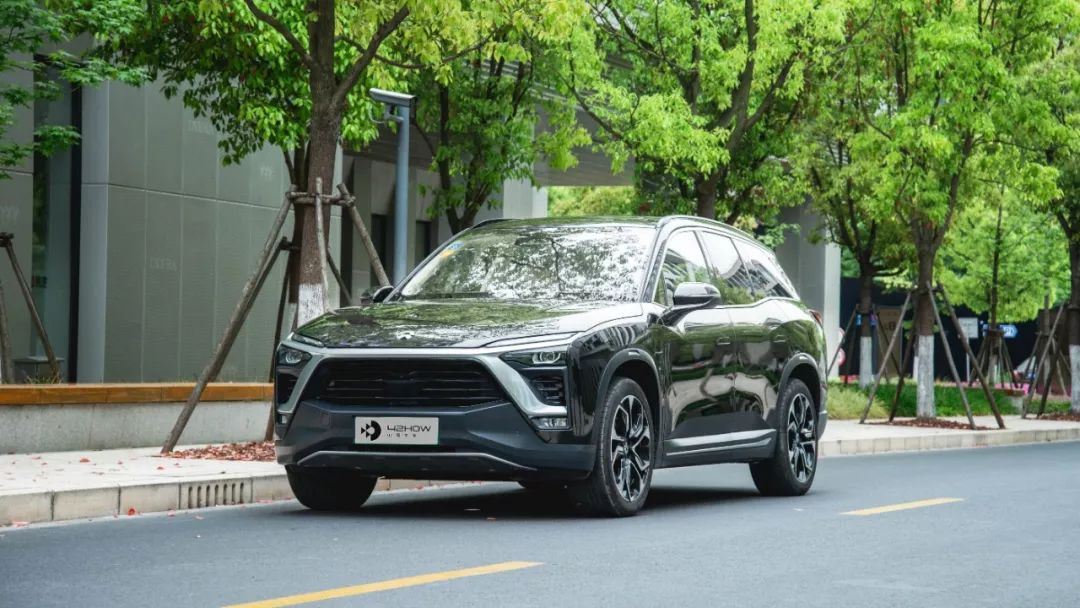
The ES8 we tested is a founding edition model, which is the top model with a pre-subsidy selling price of 548,000 yuan. The current age of the car is 9 months, with a mileage of about 18,000 kilometers, and a software version of 1.2.1-1.2.3. All measurements and experiences are based on the current software version.

At the same time as testing the NIO ES8, the 42Test evaluation system was officially launched. We have developed this independent evaluation standard based on …… The biggest difference from traditional evaluation standards is:
- Different weights
- Added three-electric and intelligent evaluation indicators
- Focus on both technological extensibility and differentiation highlights of the product
The weight of each evaluation indicator considers both user needs and our subjective preferences. We will use this set of indicators to evaluate each long-term tested vehicle.
Range and Charging
Actual range performance
Is the NIO ES8’s range short? Yes, that is the biggest negative point for the ES8 in terms of range and charging, which has a total score of 25 points, and ES8 only scored 13 points.
After all, NEDC has a range of only 355 kilometers, and according to 2019 standards, even with subsidies, only entry-level models can be purchased. How far can it actually go? After our tests, under the temperature environment of 18℃ – 25℃, driving regularly without air conditioning, the high-speed range of the ES8 is about 224 km, and the urban range is about 220 km.This data is only for reference, and the actual energy consumption of electric vehicles varies from person to person. I will analyze the energy consumption of ES8 in four sub-scenarios.
Sub-Scenario 1: Urban Commute
For urban areas, we simulate everyone’s daily habits. The battery is charged to about 90%, then the battery is consumed to about 15%, and the distance of a single trip ranges from 5-20 km. In the end, the actual driving distance is 176 km, lasting for 7 days. The average daily mileage is 25 km. The remaining displayed range is 43 km. Considering the daily habits of use, we provide energy supplementation to the vehicle. By calculation, the range of ES8 in urban areas with fully charged battery is 220 km.
The energy consumption of ES8 is relatively higher when driving at low speed (15-30 km/h) for short distance (0-10 km). Although this speed range is the efficient range for the motor, it cannot resist the weight of ES8, which is about 2.5 tons. Frequent starts lead to higher power consumption.
Sub-Scenario 2: Middle-Distance Commute on Expressway/Overpass with Moderate Speed
In this scenario, the energy consumption of ES8 is the lowest. Under suitable weather conditions, it can achieve close to 1:1 range performance. The entire journey maintains a constant speed of 60-80 km/h, without too much gear shifting, which is very friendly to ES8.
Driven 45.5 km, displayed range drop 51 km, displayed/actual range drop ratio 1:1.2, average speed 41.5 km/h.
Driven 46.6 km, displayed range drop 51 km, displayed/actual range drop ratio 1:1.09, average speed 58.5 km/h.
Sub-Scenario 3: High-Speed Driving
The energy consumption of ES8 in high-speed driving is relatively high. A colleague and I used the national grid’s charging station at Zhuji Service Area to charge the ES8’s battery to 100%. At that time, the range displayed on the dashboard was 347 km. We then drove at a speed of 120 km/h and reached Fengjing Service Area, where the displayed remaining range was 86 km. Since the distance to the next service area was about 50 km and the remaining range of 86 km was not enough to reach there, we provided the vehicle with energy supplementation at Fengjing Service Area.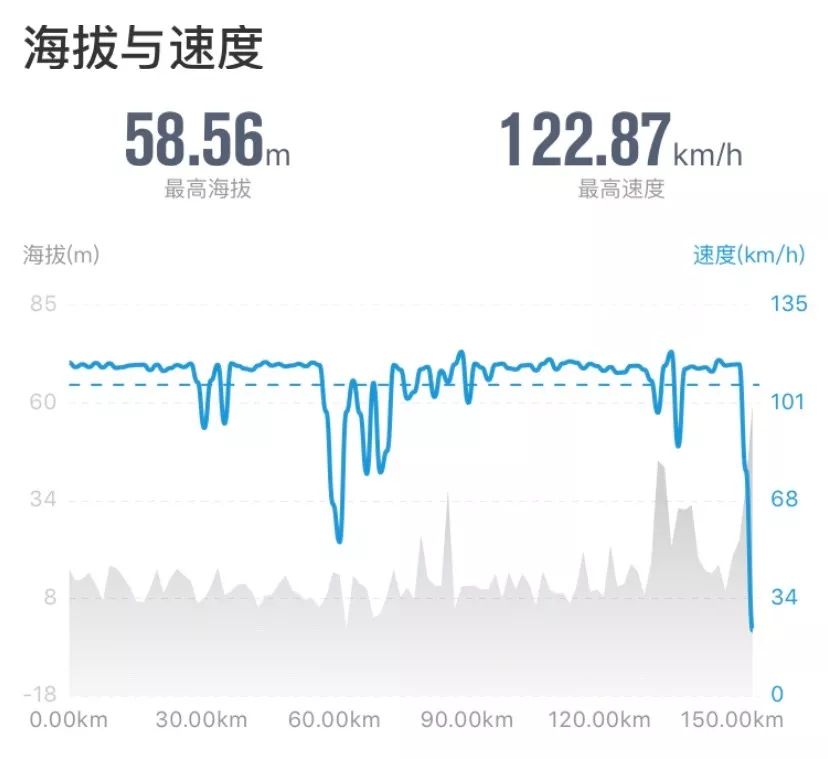
The actual mileage of the entire route is 168.5 km, with an average speed of 105 km/h. The displayed range decreased by 261 km, and the actual driving mileage changed in a ratio of 1:1.5. Therefore, we can deduce that the actual range of ES8 on a full battery is 224 km. It is well-known that electric cars consume more energy at high speeds, and the faster the speed, the faster the energy consumption increases. If the speed can be reduced to 100 km/h, the range will be significantly improved.
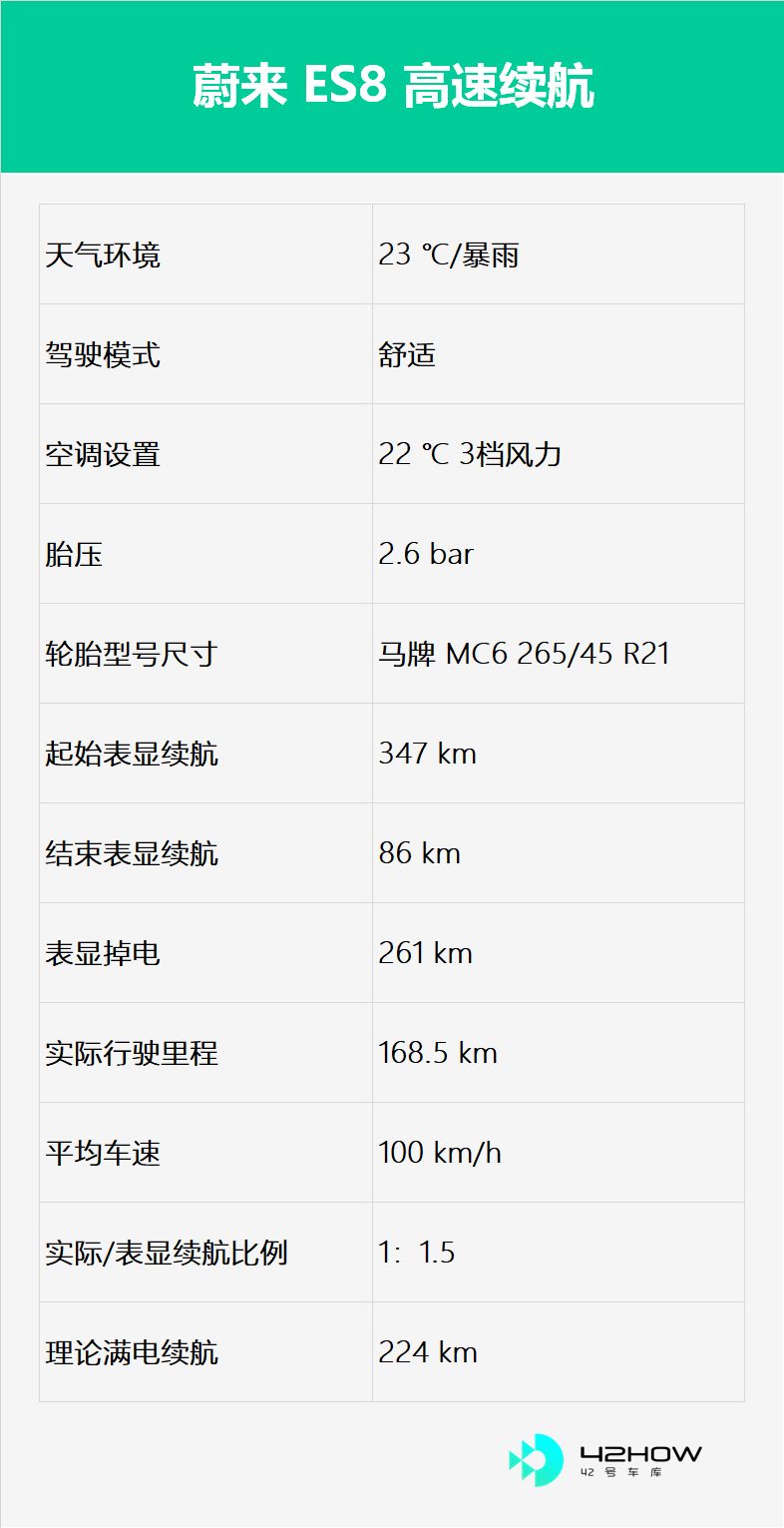
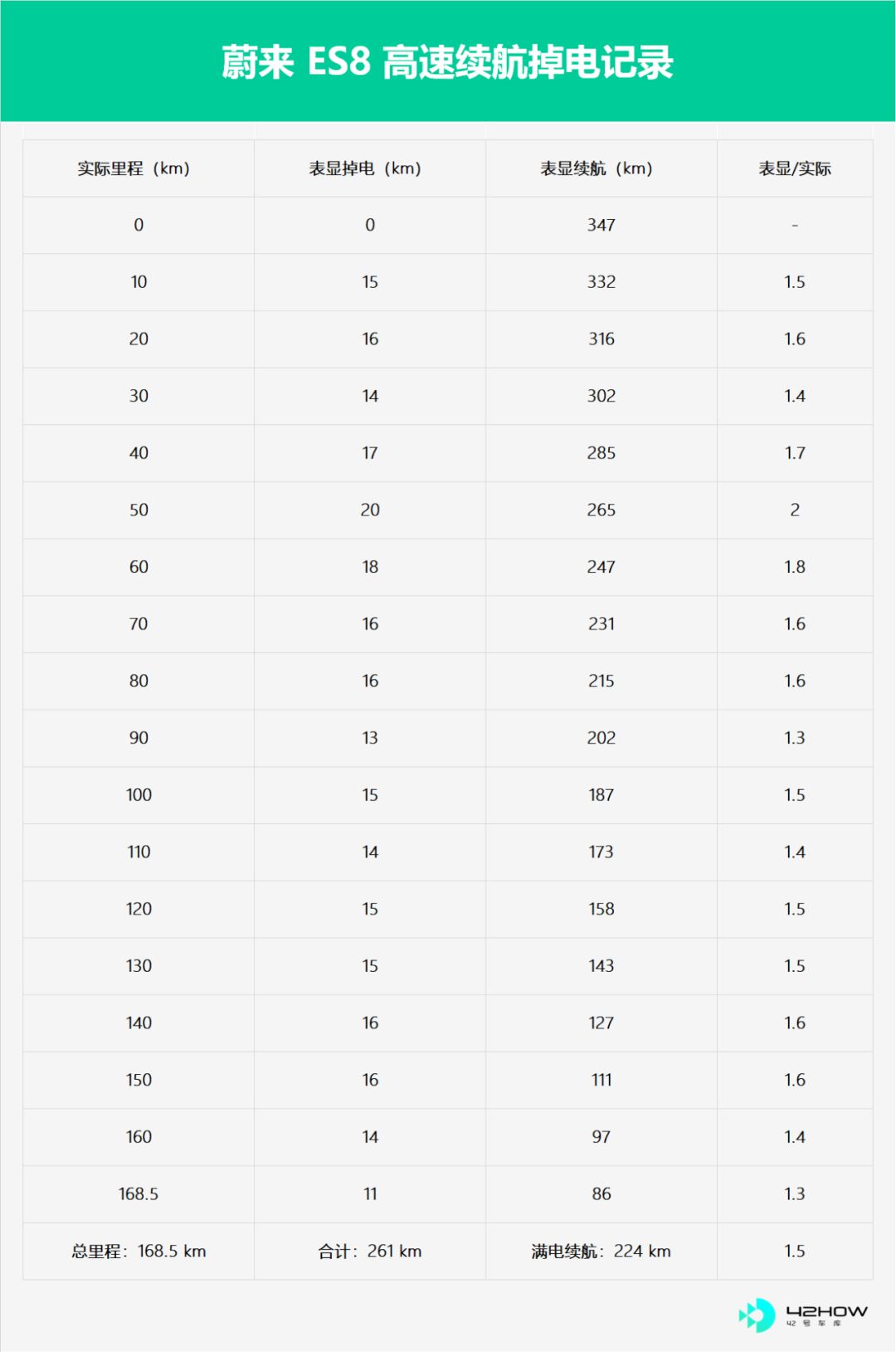
4. Low Battery Driving
When the displayed range of ES8 drops below 80 km, the overall power loss rate will increase even if the driving method is the same, and the last 80 km of range may be reduced significantly. It is speculated that the discharge performance of the battery decreases when the battery level is low (voltage is low), which causes a faster rate of power loss.
Analysis of Range Issues
As to why ES8 has such poor range performance, there are four points to consider, but it’s actually one issue.
1. High Energy Consumption – In order to achieve extreme performance, ES8 has used two high-power AC asynchronous motors. First, this type of motor needs to excite the rotor during operation, so the energy consumption is higher compared to permanent magnet motors that do not require excitation. Second, the total maximum power of two motors is 480 kW, with a maximum torque of 840 Nm, achieving a 4.4-second 0-100 km/h acceleration level. As a performance car, anyone who gets into it will experience its 4.4-second acceleration speed, and no one wants to drive slowly with 480 kW power under their feet. It’s like how everyone talks about the high fuel consumption of Mercedes C63. While C63’s fuel consumption is indeed high, it’s not exaggerated; it’s just that everyone wants to step on the gas pedal a few times.## 2. Compromise on Space and Resistance
ES8 chose space over resistance, and the 0.29 Cd resistance coefficient is already impressive for an SUV of this size. However, it still falls short compared to Tesla Model X, which has a 0.25 Cd coefficient by sacrificing interior space. As a result, energy consumption during high-speed driving is also affected.
3. Small Battery
The battery cells of ES8 are from CATL with an energy density of 135 Wh/kg, and the 70 kWh battery pack can actually only provide 67 kWh of usable energy. Therefore, the range is naturally shorter. There are three reasons why ES8 did not choose a larger battery. First, when ES8 was launched, energy density was generally limited to 130 Wh/kg to 140 Wh/kg due to technical constraints. Second, to match NIO’s unique battery-swapping system, ES8 had to use a battery pack that was also compatible with ES6. Thus, ES8 could not fully utilize the chassis space to lay out a larger battery. Third, the price of power batteries has always been high, so cost is also one of the reasons.
Although NIO has introduced an 84 kWh version of the battery pack, which increases NEDC range to 425 km, there is only a quantitative improvement in actual experience. Many owners have stated that the range is sufficient for city driving, and the 50 km improvement in highway range is not significant enough to consider upgrading yet. If a 100 kWh version battery pack is released, they might consider upgrading.
4. Air Conditioning Consumption
ES8’s cabin is huge, and in order to quickly reach a comfortable temperature in hot summers or cold winters, it uses two PTC heaters with full load power of 5.5 kW and 3.7 kW respectively, for a total power of 9.2 kW. Therefore, energy consumption while using air conditioning is also high.
Overall, NIO’s low range is mainly due to its concept of car-making. NIO has built a relatively perfect power supply system and believes that after the service system is perfected, the pain points of electric vehicles in travel have been eliminated. Therefore, when developing ES8, they did not prioritize range. To achieve many goals, compromises had to be made.
Charging Performance
After discussing power consumption, let’s take a look at charging. Since we do not have a fixed parking space or a home charging condition, we need to use public charging stations to recharge the vehicle. Based on our usage habits and ES8’s range, we need to recharge the vehicle once every 3-10 days. NIO’s one-click charging service is very convenient, so we used it for recharging during our test except for testing charging speed. Thus, we did not experience any inconvenience while using ES8 due to charging problems.If you need to recharge at a third-party charging station, we also tested the charging speed of ES8.
We set the display of ES8’s remaining mileage to 0 km and the remaining battery capacity to 0% displayed on the dashboard. Then, we used a Techrules fast charger to recharge the vehicle. There were three Techrules fast chargers available, sharing a total of 150 kW charging power. During the charging process, I was the only one using the fast charger.
The total charging time was 112 minutes. The initial charging power was about 40 kW and the charging current was maintained at 110 A to 120 A. As the voltage increased, the charging speed also slightly increased. This charging power lasted from SOC 0% to SOC 84%, after which the charging current decreased to about 64 A. That is to say, it took 77 minutes to charge from 0% to 80% and 34 minutes to charge from 80% to 100%.
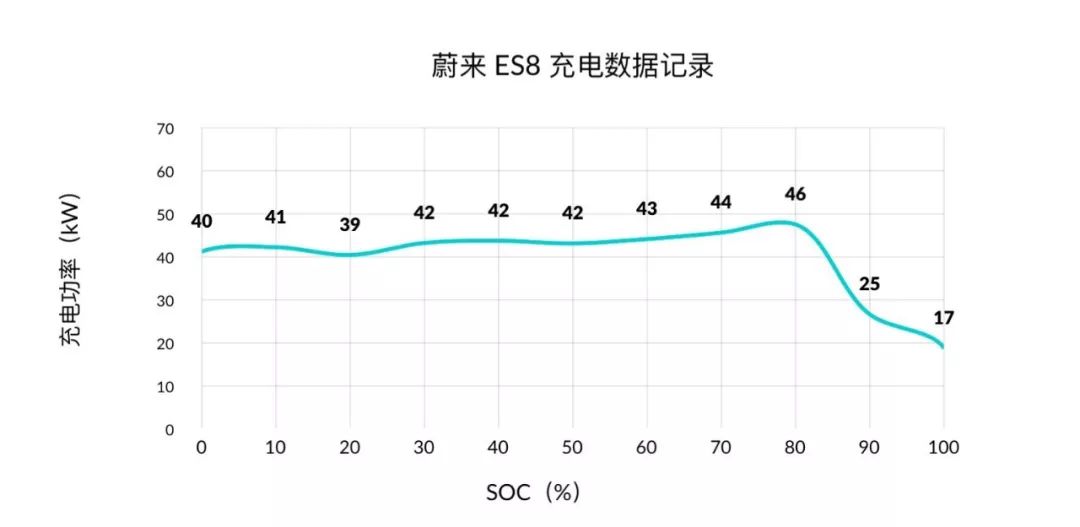
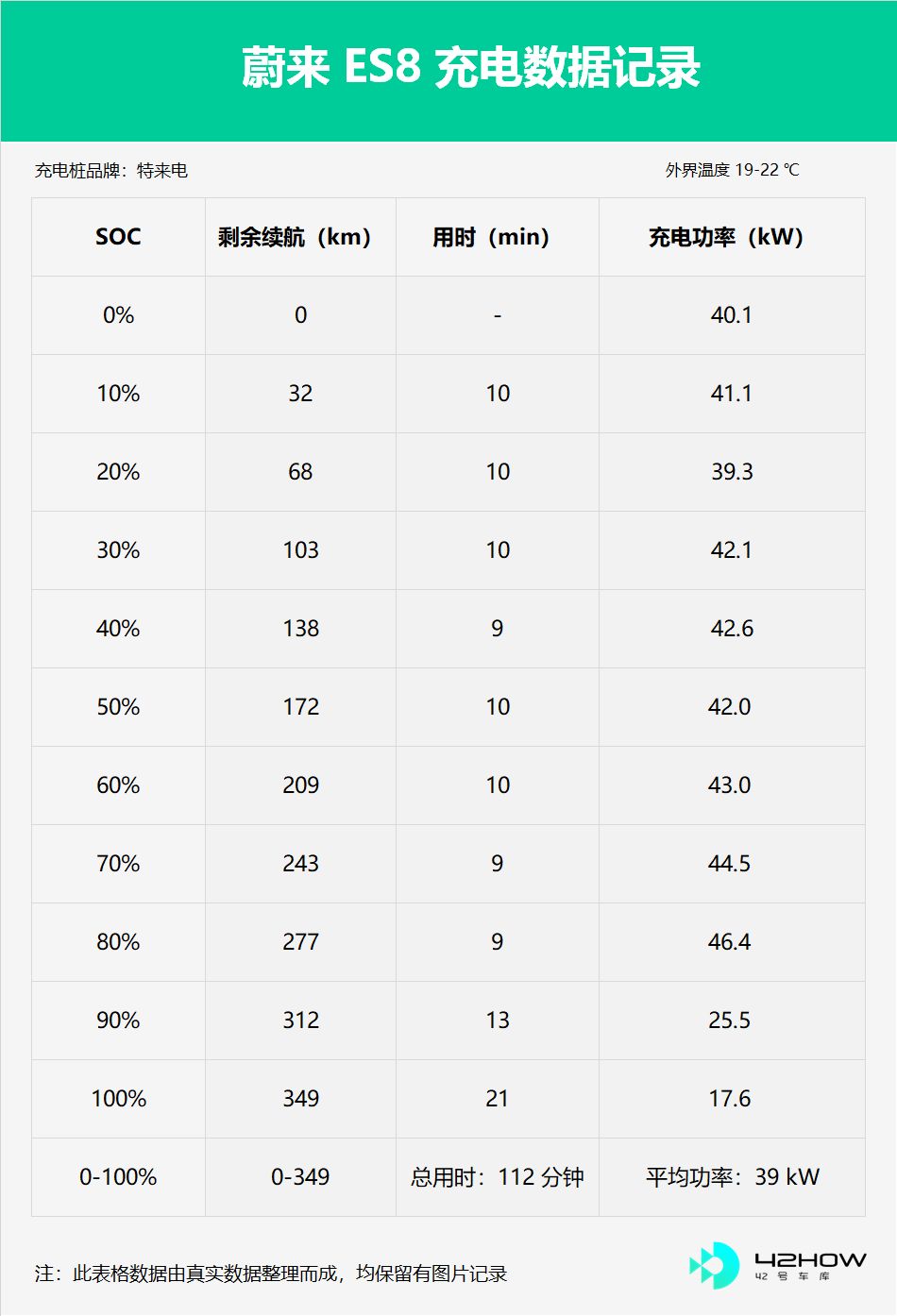
In addition, under the same temperature conditions, when charging from about SOC 20% to 30%, the charging power of three different State Grid 120 kW fast chargers at different locations was 31.8 kW, 47.7 kW, and 81 kW respectively.
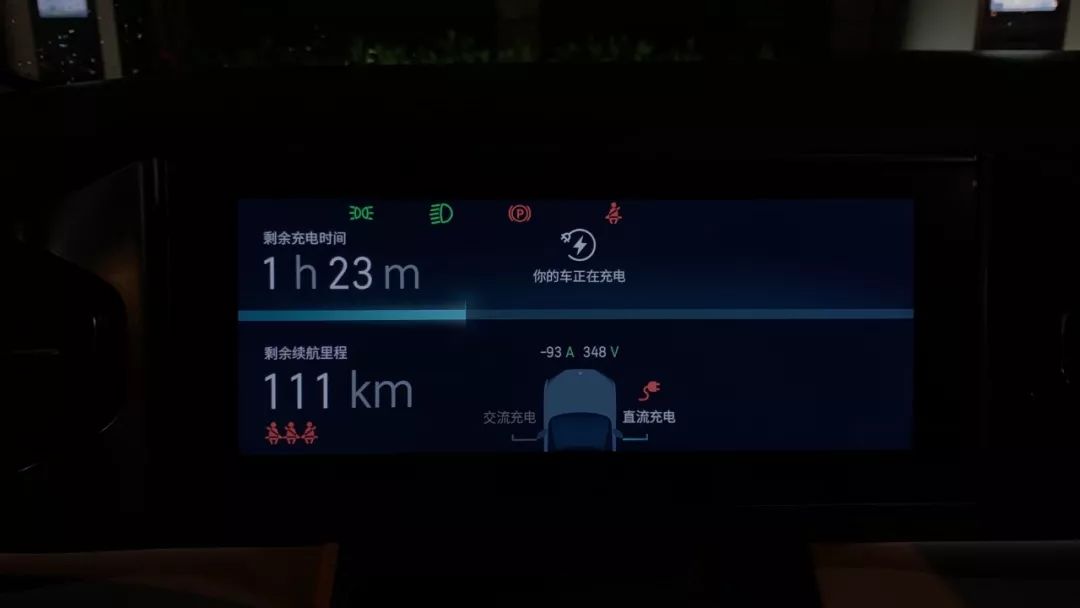
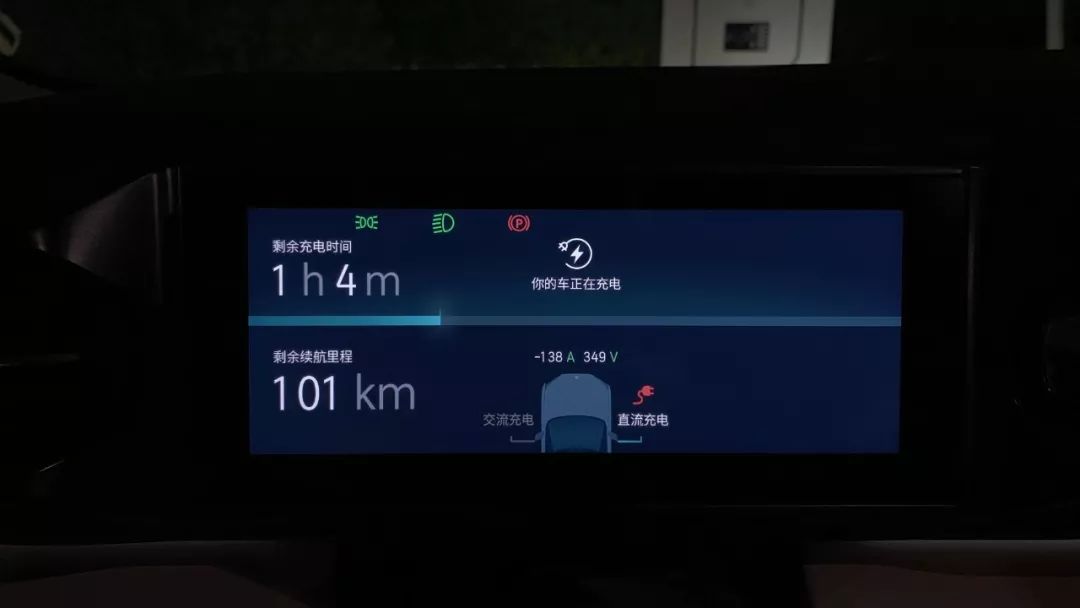
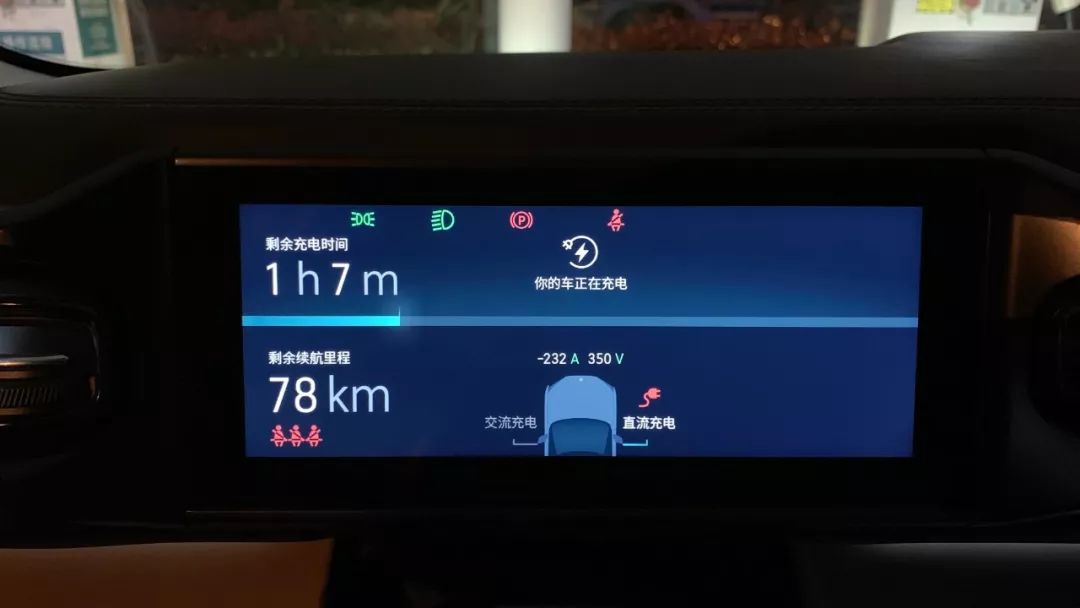
Therefore, the charging stations have a great impact on charging speed, and most of them have actual charging power of around 40-50 kW, which may not provide the best charging experience. However, it is worth mentioning that NIO is building its own brand fast charging stations, and the stability and charging speed should be guaranteed to some extent. We will also perform a retest of ES8 charging speed when the new charging stations are ready.
DrivingBased on the positioning of the ES8 luxury midsize SUV, it scored 22 out of 30 points for dynamic performance.
To start with the conclusion: From a hardware perspective, the ES8 is a perfect car, but due to some calibration issues, the actual experience of the ES8 is not as powerful as the hardware presents.
Let’s break it down.
Chassis: The ES8 uses a front double wishbone and rear multi-link suspension structure, as well as air suspension from the mainland, which is very generous in terms of hardware, and the chassis architecture comes from the Maserati Levante. However, due to the hasty launch of the ES8, NIO did not have time to calibrate the suspension characteristics for the ES8, so the suspension experience of the ES8 on some roads is relatively average.

The handling limit of the chassis is relatively high, and the overall feeling is very heavy. It is very stable and comfortable at high speeds. When faced with some small bumps, the suspension performance is decent, but when encountering some larger bumps, the ES8’s suspension is not satisfactory. When passing over a single big bump or a continuous section of bumpy road, the filtering of vibration by the suspension is not firm enough, and the body will produce a large lateral swing. At this time, the experience of both the driver and the passenger is not comfortable enough. As an SUV that leans towards comfort, I cannot accept this.
Power: After our actual testing and inspection, the ES8, which has a mileage of nearly 20000 kilometers and is 9 months old, has an acceleration of 4.2 seconds per hundred kilometers, exceeding the official 4.4 seconds per hundred kilometers acceleration score.
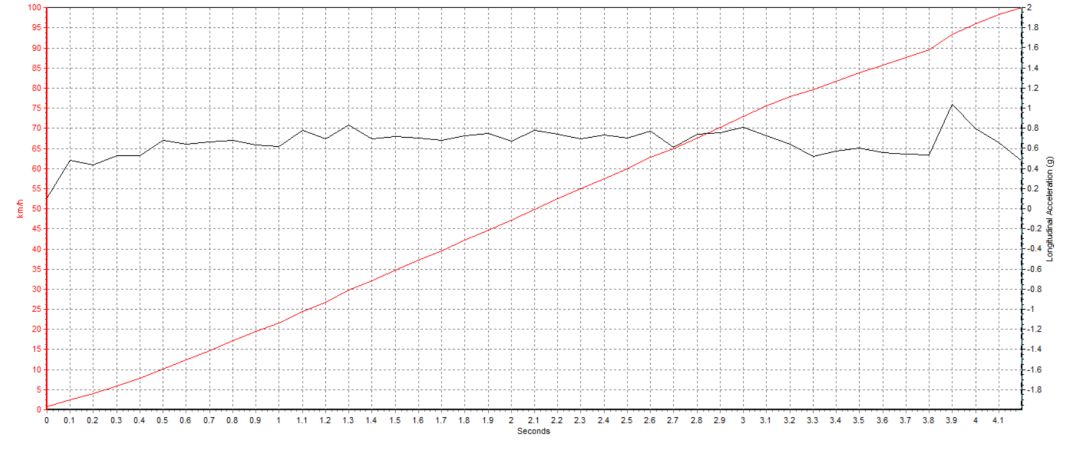
For a heavy midsize SUV weighing 2.46 tons, this is a very impressive performance. In order to achieve this score, NIO arranged a 240 kW AC asynchronous motor on the front and rear axles of the ES8, and this also shows that performance is a label that NIO wants to achieve on the ES8. Therefore, in terms of range and performance, the ES8 leans towards performance.
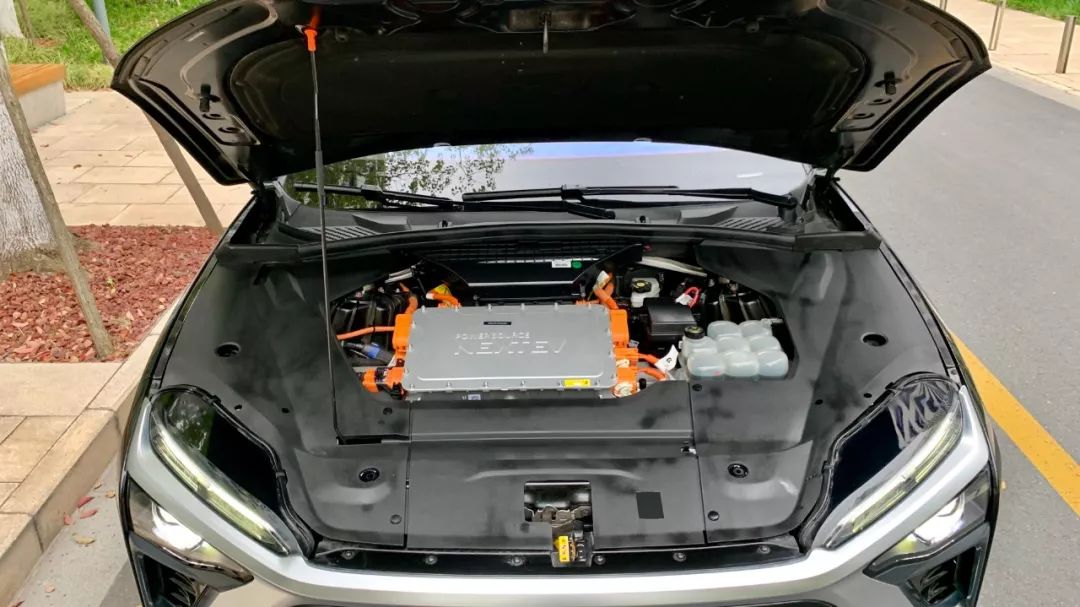 In addition, the ES8 is equipped with inverters from Infineon (responsible for converting the direct current in the battery into alternating current suitable for the motor), with the core component being the IGBT, whose ability directly determines the size of the output power. NIO stated that if not limited by the ability of the IGBT, the peak output power of the two motors can be pushed to 300 kW.
In addition, the ES8 is equipped with inverters from Infineon (responsible for converting the direct current in the battery into alternating current suitable for the motor), with the core component being the IGBT, whose ability directly determines the size of the output power. NIO stated that if not limited by the ability of the IGBT, the peak output power of the two motors can be pushed to 300 kW.
When driving at low speeds, the ES8’s power is provided by the rear motor, while at high speeds, it is provided by the front motor. When there is high demand for power, both the front and rear motors output at the same time.

For the ES6, NIO has made some changes. The motor combination for ES6 is 160 kW front permanent magnet synchronous motor and 240 kW rear asynchronous motor. In most cases, the ES6 is driven by the front permanent magnet motor only. Only when the power demand is high will the 240 kW rear motor be used. Therefore, from this point, it can be seen that NIO has started to weigh the performance and range, and has chosen a compromise solution for ES6.
Under the comfort mode, the ES8’s acceleration score is 6.9 seconds, which is sufficient for overtaking during normal driving. If adjusted to sport mode, the air suspension will be lowered by one level, and the acceleration time for 0-100 km/h will be 4.4 seconds. At this time, if you want to step on the accelerator pedal, you must remind the passengers in the car to be prepared, because there will be a feeling of approaching weightlessness.
In actual experience, there is no problem with the power output of the ES8 during normal driving, and it accelerates very easily. Even when the speed reaches 120 km/h, the power is still abundant.
However, in the case of aggressive driving and slamming on the accelerator pedal, the ES8’s power output is not quite responsive, with a slight delay. When you give it full throttle, the power does not immediately come out like a burst, but there is a noticeable delay, especially when driving at low speeds. The official explanation is that this setting is actually to protect the ES8’s half-shaft. The torque of 840 Nm is too powerful, and in the moment when the 2.46-ton body is lifted up, the half-shaft cannot bear such a large twisting force, so a slight delay is set in the output.
Therefore, NIO has optimized the hardware for the next generation of models. The ES6 has adopted an integrated drive shaft design. In my brief actual experience, the ES6’s accelerator pedal has no delay. Later, we will try out more driving conditions and perform a comprehensive evaluation of the ES6.Brakes: To restrain the 480 kW power, ES8 adopts Brembo manufactured brake calipers and Bosch iBooster first-generation brake system. After our test, the braking distance for 100 km/h is 37 meters, which is still an outstanding result despite the slight difference from the official figure, given the car’s 9 months of age and tire wear.
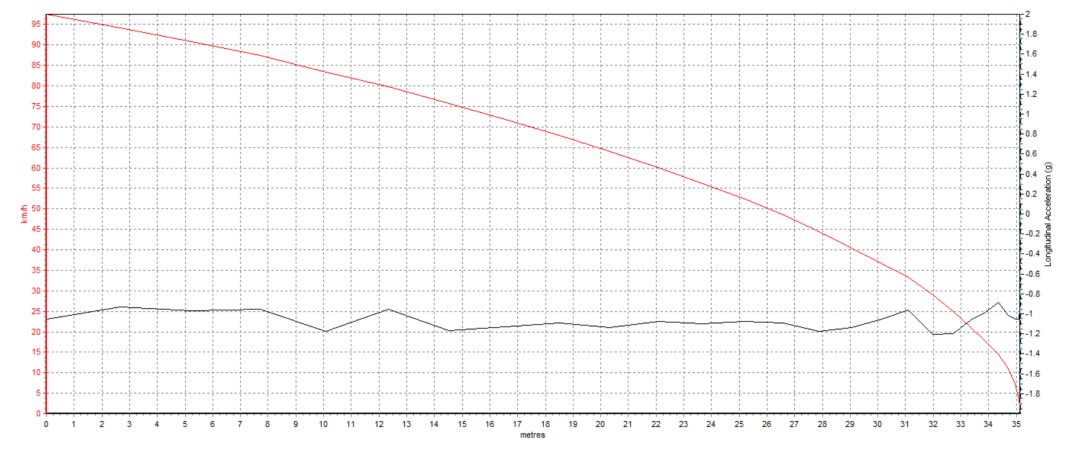
Of course, the excellent braking result can’t be achieved without four 265 mm width Pirelli MaxContact MC6 tires, which focus on braking distance, handling performance and quietness.
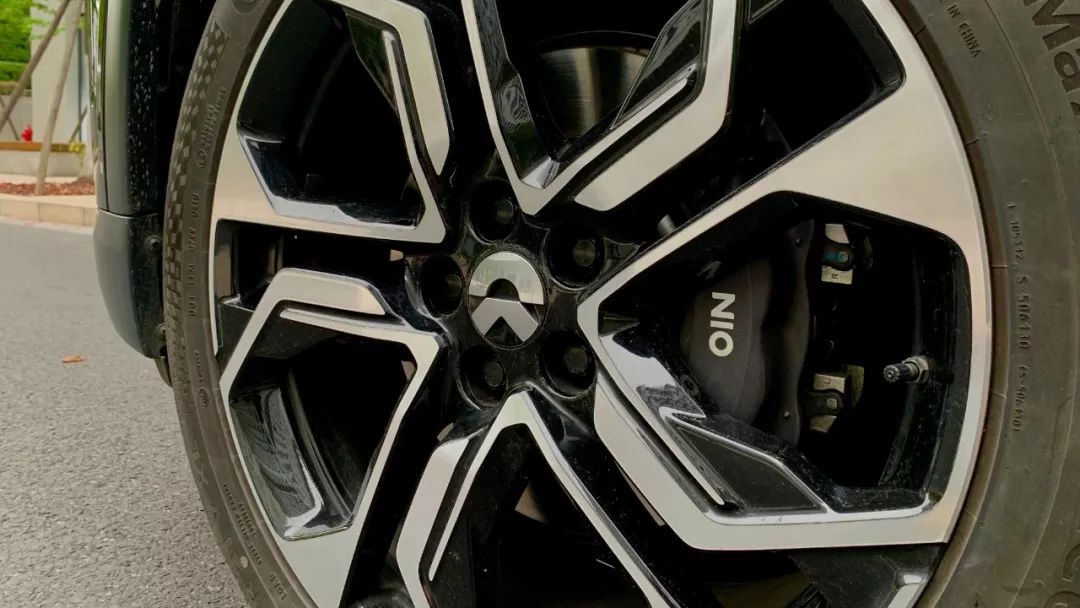
Although the braking performance of ES8 is excellent, the brake feel is not particularly good. It can be divided into two types: electric braking and mechanical braking.
Electric braking: Electric braking is also regenerative braking. ES8 has two adjustable modes: Standard and Gentle. In Standard mode, the regenerative braking force is very strong, and the maximum regenerative power measured can reach 80 kW. If you are used to the one-pedal operation logic, the overall driving experience is still very good because the electric braking force is very linear and controllable. In most cases, only mechanical braking is needed when stopping.
If you are not used to regenerative braking, you can adjust the intensity to Gentle in the settings. At this time, the drag feeling after releasing the accelerator will be much lighter than that of a fuel car. However, it is not enough to quickly reduce the vehicle speed, and you need to use the brake pedal to reduce the speed.
Mechanical braking: The brake pedal of ES8 does not integrate electric braking, and the entire stroke is mechanical braking. The front section is very light with weak braking force, while if you press it further, the feel becomes hard and the braking force is stronger. Overall, the brake feel and braking force of ES8 are not sufficiently linear.
Steering: In terms of steering, the grip feeling of ES8 steering wheel is excellent. There are three adjustable modes of steering feel: Comfortable, Standard, and Stable.
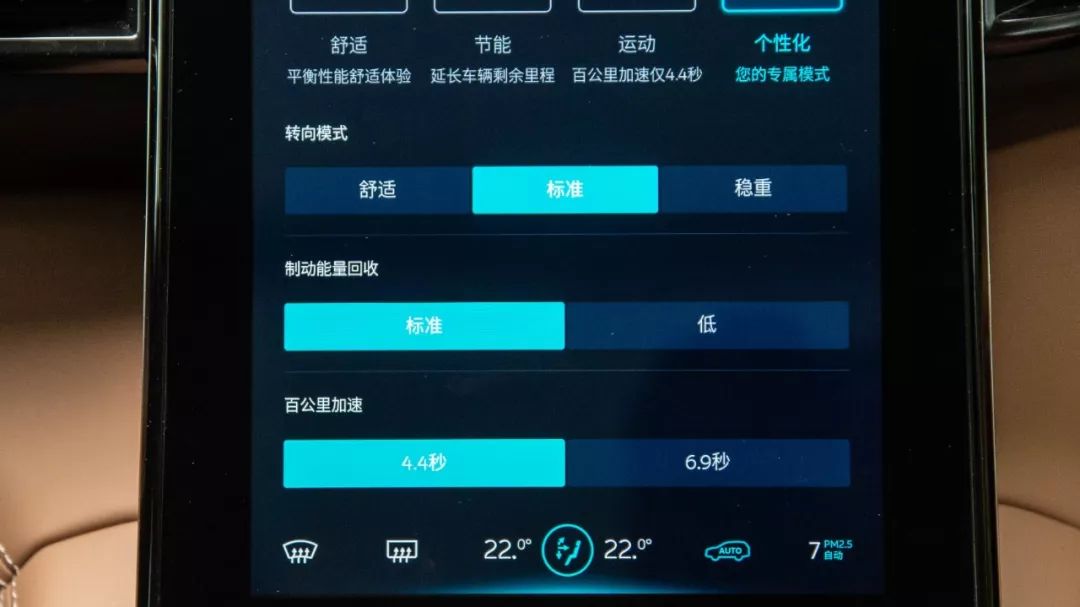 ## Comfort Mode
## Comfort Mode
In Comfort mode, the steering feel is very light, and there is some play in the initial stage. It is completely biased towards comfort, making city driving very easy. However, the steering returns to center relatively slowly, and there is some large play in the initial stage during high-speed driving over bumpy roads. The road feel transmitted to the steering wheel is somewhat vague and delayed. From the perspective of comfort, there is not much of an issue with this calibration.
The other two modes gradually increase the weight of the steering, but overall it is still light and not tight enough. The play in the initial stage still exists, and the directional stability of the front end is good during aggressive driving, but the overall body dynamics following is average. After all, this is an SUV, so don’t expect the handling to be excellent.
Infotainment System
After examining the two core aspects of range and driving, let’s take a look at NIO’s software, which has been criticized the most. This is also the car’s drawback.
The infotainment system can be divided into two main areas:
First, the functionality of the infotainment system. What functions can this system perform? This not only includes commonly used features such as air conditioning, multimedia, and navigation, but also other functions such as voice control, OTA updates, and more.
Second, the ease of use of the infotainment system. Is the system optimized for the vehicle’s usage scenarios, allowing drivers to easily find where each function is located and complete vehicle settings with ease?
Although the ES8’s infotainment system is very feature-rich, it is not very user-friendly in terms of usability and there is a lot of room for improvement in terms of logical use. Therefore, we would give the ES8 only 6 points for its infotainment system out of a possible 10.
NIO has put a lot of effort into building a comprehensive service system to greatly improve user experience, to demonstrate their focus on user experience, and yet they seem to have forgotten about the UI design of the infotainment system and instrument cluster.
Contrary to early opinions, the probability of software bugs in the current version is very low compared to when the ES8 was first launched. I encountered just 2 minor bugs during my month of use. One time the reversing camera did not display, but after changing to “Park” mode and then back to “Reverse,” it resumed functionality. The other time, after the car was unlocked by a charging personnel, the permissions were not switched back to the owner, resulting in many entertainment functions being unavailable. After locking the car and letting it sleep, then waking it up again, the functions were restored. Throughout the usage cycle, there were no cases of crashes, blackouts, or display issues.
Based on the state of version 1.2.1 to 1.2.3, let me discuss some of the details of the ES8’s software performance.## ES8 Interactive Screens
The ES8 has two interactive screens, an 8.8-inch instrument panel and a 10.4-inch central display, both with wide black borders reminiscent of the 2012 iPad 2. However, NIO has recently introduced new screens with an 11.3-inch display boasting narrower borders and an overall improved design. Let’s take a closer look at the functionality and UI design of both screens.
Central Display:
The central display of the ES8 has good basic qualities such as screen resolution, touch sensitivity, and system fluency, and it comes pre-installed with useful software including Baidu Maps, QQ Music, and Himalaya. These apps can cover most of the usage scenarios encountered during driving and help users stay independent from their mobile phones.
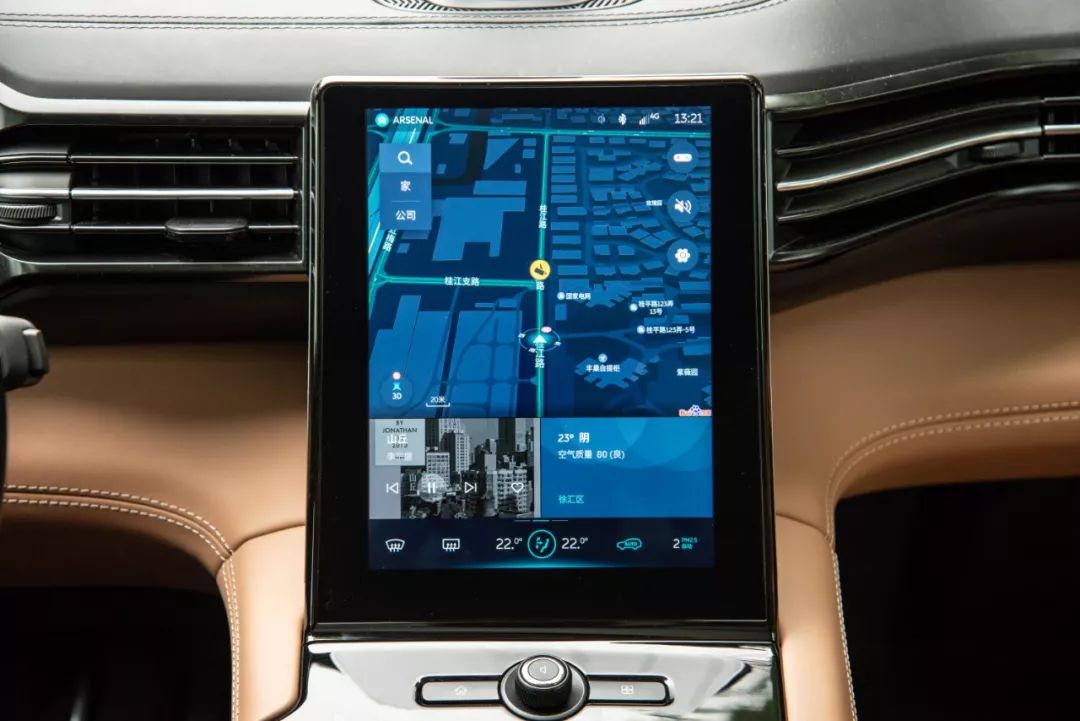
However, when it comes to the convenience of operating the car’s features, NIO falls short. There are two ways to control these features: through the touch screen and buttons or by voice command. However, information related to driving cannot be adjusted through voice control, and manual operation is required. Let’s first examine the UI design drawbacks.
1. The entire system lacks a deep optimization based on actual driving scenarios, and many functions are buried deep within the menu. For example, adjusting the steering wheel sensitivity requires five clicks, from the initial screen to completion, making it not particularly convenient to adjust functions through the touch screen.
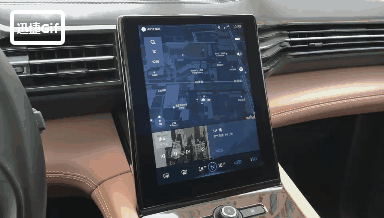
2. There isn’t a complete categories page, making it necessary to search for various settings pages.
For example, vehicle settings and system settings are scattered in two different locations, and the items in the vehicle settings menu are not particularly clear. If you want to adjust driving-related performance settings, even if you have entered the driving mode, you still need to click on the personalized setting page to adjust power, suspension, steering, and kinetic energy recovery settings.
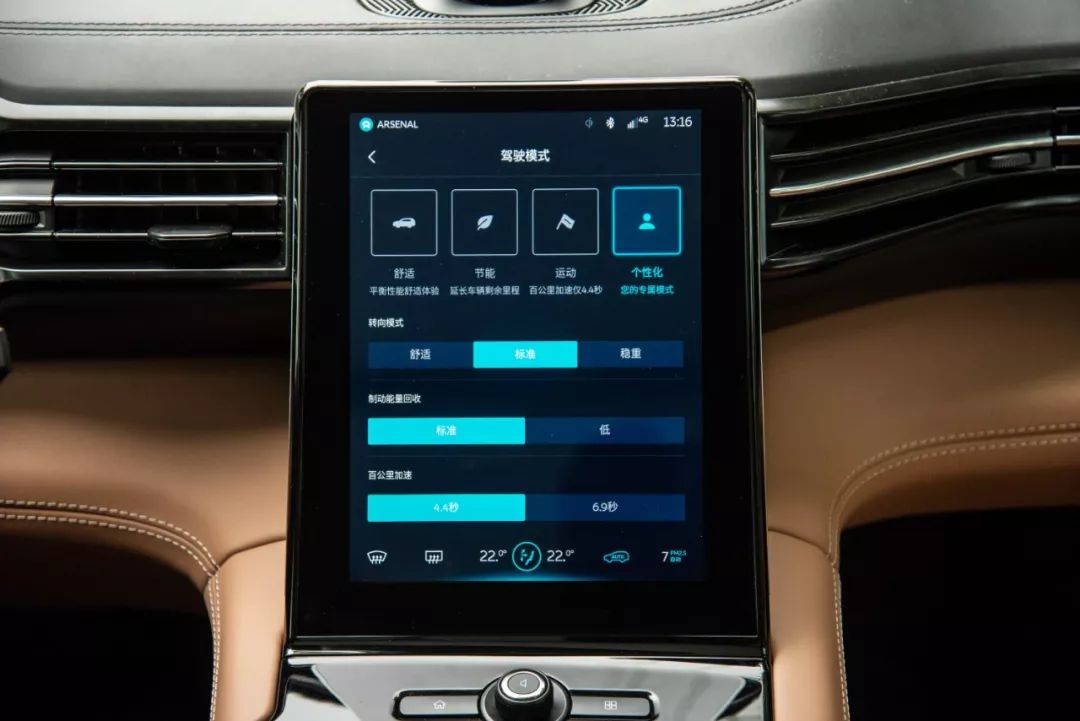
3. The ES8 infotainment system’s Dock bar only includes the air conditioning system, making it impossible to quickly enter other pages or apps. (What is the gap between quick and not quick, and what are the details?)# 4: Some car infotainment systems display all functions in floating windows, and clicking on the blank space returns to the main interface. However, once entering a function in ES8, the entire screen is occupied. It is not very convenient to click on the exit button in the upper left corner while driving. Fortunately, ES8 retains a physical “Exit” button.
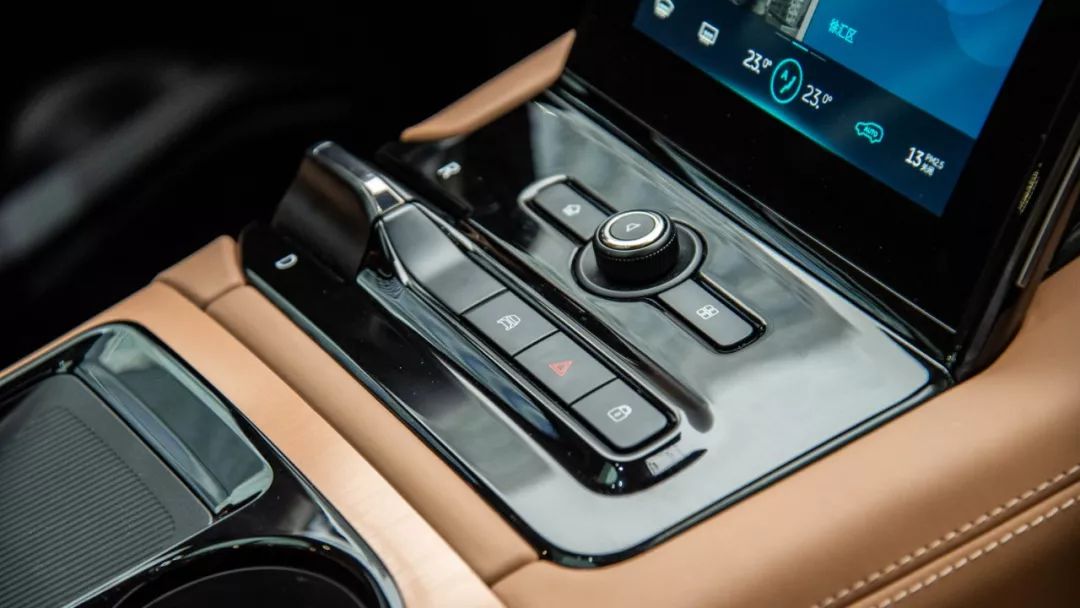
Most of the other vehicle settings unrelated to driving can be completed by using voice control to call Nomi, such as setting navigation, adjusting the air conditioning, turning on the seat massage, and opening the windows. Nomi is one of NIO’s core selling points. NIO has invested a lot of effort in Nomi’s expressions and daily language communication. If you are used to using voice control, Nomi can help you complete some basic operations to a certain extent.
Let’s talk about several basic functions.
Reverse Image: Reverse image is the second software that can fully utilize this large screen, but the four surround-view cameras responsible for ES8’s reverse image have a mediocre resolution, and the splicing of the wide-angle lens picture and the edge distortion are not good enough.
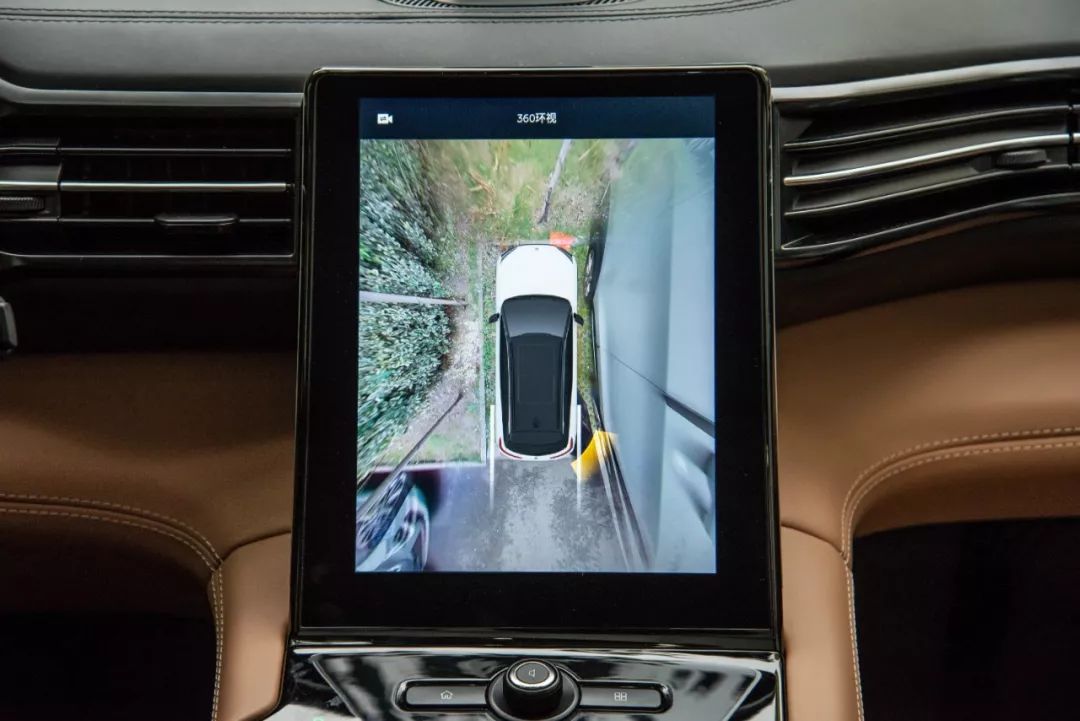
In addition, this large screen can only display 360-degree surrounding view or only show the rear view image, and cannot display the picture of a single camera while showing the 360-degree image at the same time. Especially when backing up, if I choose the surround view, I can only see the distance of the rear 3 meters. If I choose the rearview image, I cannot see the obstacles around the front of the car. Therefore, I strongly recommend optimizing the splicing and distortion algorithms in the later stage and supporting the display of multiple viewpoints in the same interface.
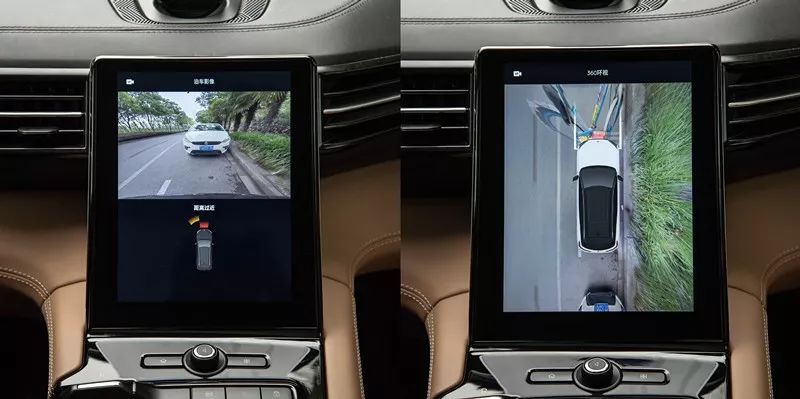
Reverse Radar: After the ES8’s reverse radar detects obstacles, the display on the central control screen is not intuitive enough.
Secondly, the alarm sound of the reverse radar is also very confusing. When the radar detects obstacles but the distance is far away, the sound is”Dudu dudu” means the proximity warning when the distance is relatively close, while “dada dada” indicates a closer distance, but the system’s recognition is somewhat ambiguous. Sometimes it is still “dudu dudu” when the distance is very close, and sometimes it alternates between “dudu dudu” and “dada dada” when you stop, making the whole process of reversing into a parking space seem like a symphony performance. This makes the warning sound of the radar not particularly helpful in practical use.
In addition, the front radar of ES8 is not automatically turned on when driving at low speed, which means I have to manually turn on the panoramic image every time I pass through a narrow section at low speed, which is not particularly convenient.
Instrument Panel:
The instrument panel is the second-largest screen in the car, with a screen size of 8.8 inches, but NIO has not made the most of this screen.
First of all, real-time power is displayed on the instrument panel, showing the current output power and current kinetic energy recovery power, which is great. However, the symmetric design of speed information and real-time power information is not convenient to read, and it is not clear which is more important. The position should be adjusted to highlight the speed information.
Secondly, the display of auxiliary driving information in the lower left corner is quite rough. I hope that after the release of NIO Pilot, the display can be optimized.
Thirdly, the lower right corner displays multimedia information, which is very reasonable, but the amount of content to be displayed in this area is too much. This area can be switched between media, vehicle status, and driving modes through the buttons on the steering wheel.
In the media section, you can select and play audio sources, such as radio and Bluetooth from a mobile phone.
As for the driving modes, there is nothing special to say. (Is there anything to say about the calibration of driving modes and the differences from other manufacturers?)
In the vehicle status section, you can see the trip mileage, total mileage, and motor status, all of which are very practical. However, if you choose to display multimedia information, you won’t be able to see the trip mileage and motor status. If you choose to display the trip mileage, you won’t be able to adjust the music or volume with the buttons on the steering wheel.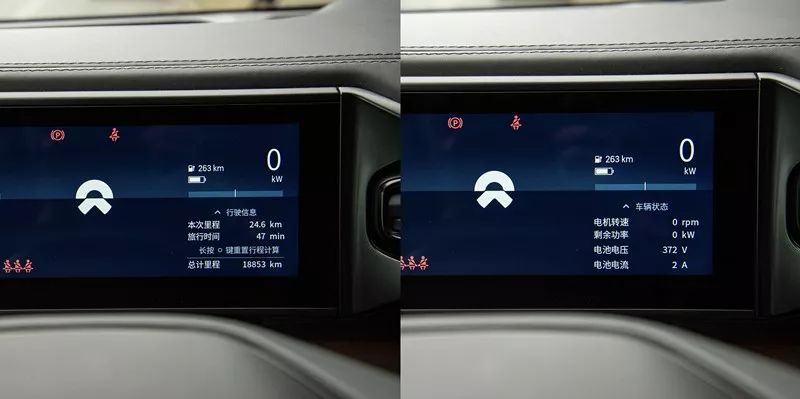
The calibration is not good. Most car owners want to see this information at the same time, and the information of the subtotal mileage is not sufficient, as it can only display the mileage and time of the current trip, and cannot set the collection range of the subtotal mileage.
Fourth: When navigation information is not displayed in the central area of the dashboard, only the NIO logo is displayed. Although the logo looks good, displaying such a large area for a logo is a waste. It is better to display speed information or display the surrounding vehicle information after NIO Pilot is launched.
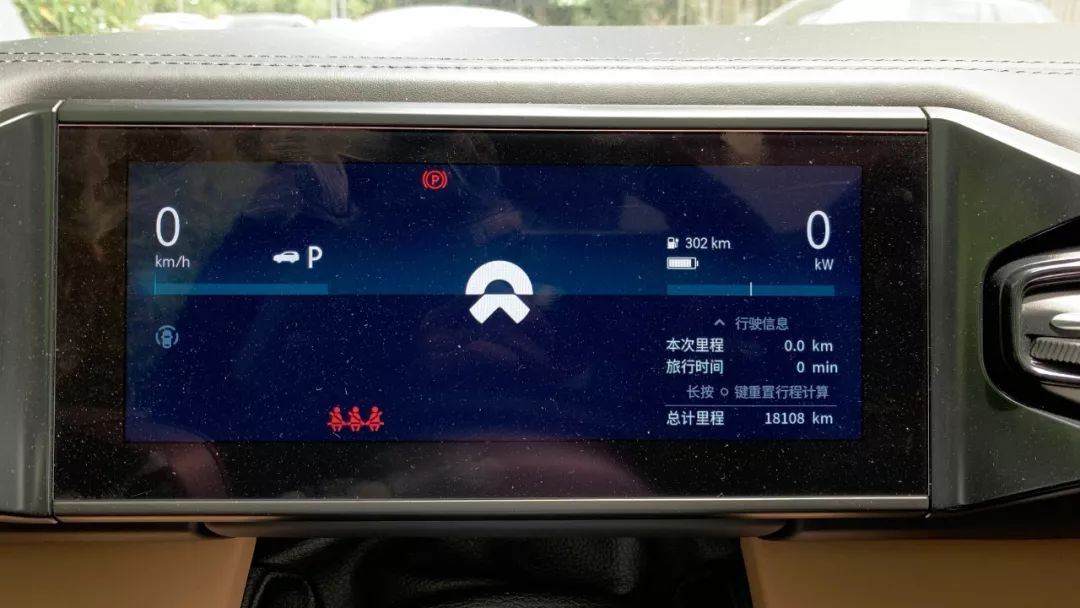
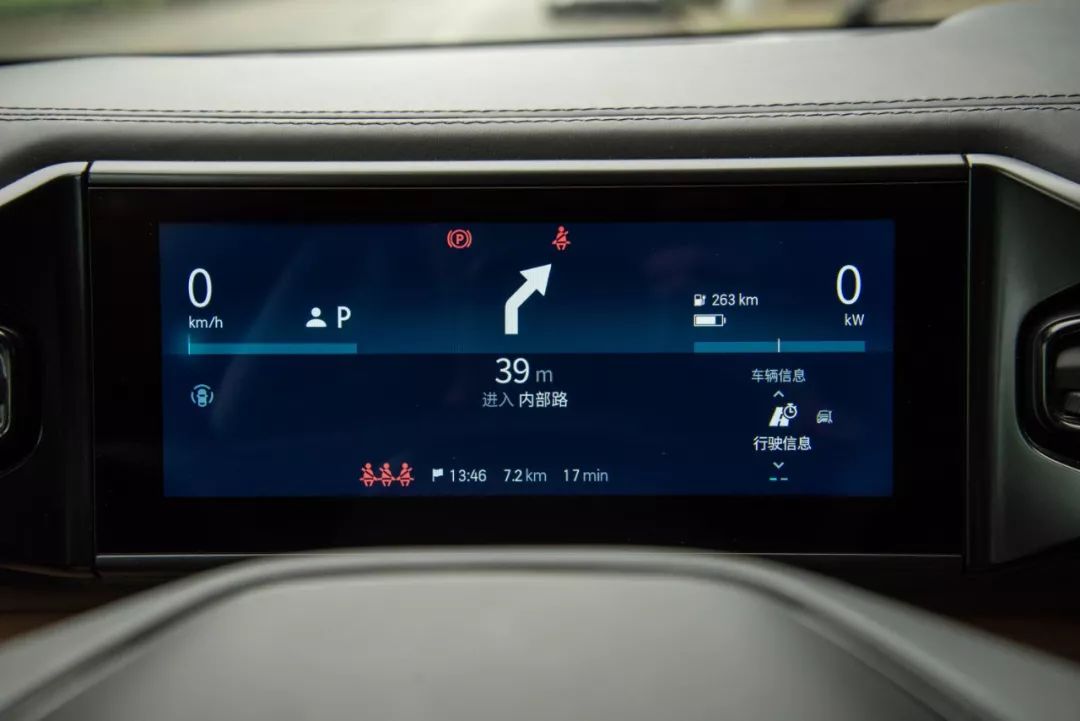
When navigation is enabled, the middle area displays navigation information, but only one instruction is displayed instead of a thumbnail of the navigation. This setting is not reasonable.
By the way, NIO’s HUD can display speed information, navigation information, and cruise control information, covering most of the data requirements during driving.
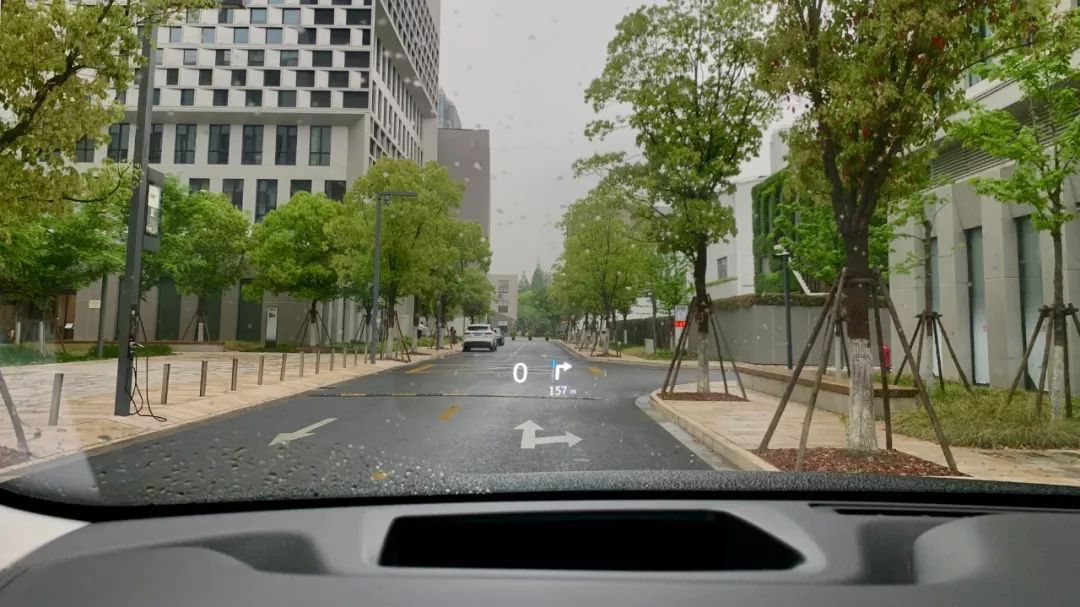
Fifth: There is a lack of display of basic information on the dashboard, such as time, temperature, total mileage, energy consumption, etc.
Finally, there is a logical issue:
Power-off logic: Since electric cars do not have a start button, simply stepping on the brake can engage the gear and move forward. Note that two conditions must be met here: first, the driver must be seated, and second, the brake must be pressed, which can be understood as starting the vehicle. However, after parking, if the driver leaves the vehicle, some of the electronic facilities within the vehicle will be powered off. Although the central control screen and air conditioning can still be used normally, the windows and sunroof cannot be adjusted. This calibration is very inconvenient during actual use.
Autonomous Driving
In addition to the in-car system, another important software component is autonomous driving, which is also where NIO falls short. ES8 only scored 8 out of 15 in assisted driving.
ES8 has the following standard configurations:- 1 front-triple camera
-
4 surround-view cameras
-
5 millimeter-wave radars
-
12 ultrasonic radars
-
1 in-car camera
-
1 Mobileye EyeQ4 vision processing chip
This set of advanced driving assistance system (ADAS) hardware has a comprehensive layout, and the Mobileye EyeQ4 chipset has strong computational power. However, the current software can only achieve ACC adaptive cruise control, which is somewhat outdated compared to the L2 systems that are filling the streets today.
Because it is only a simple active follow function, let me briefly mention it.
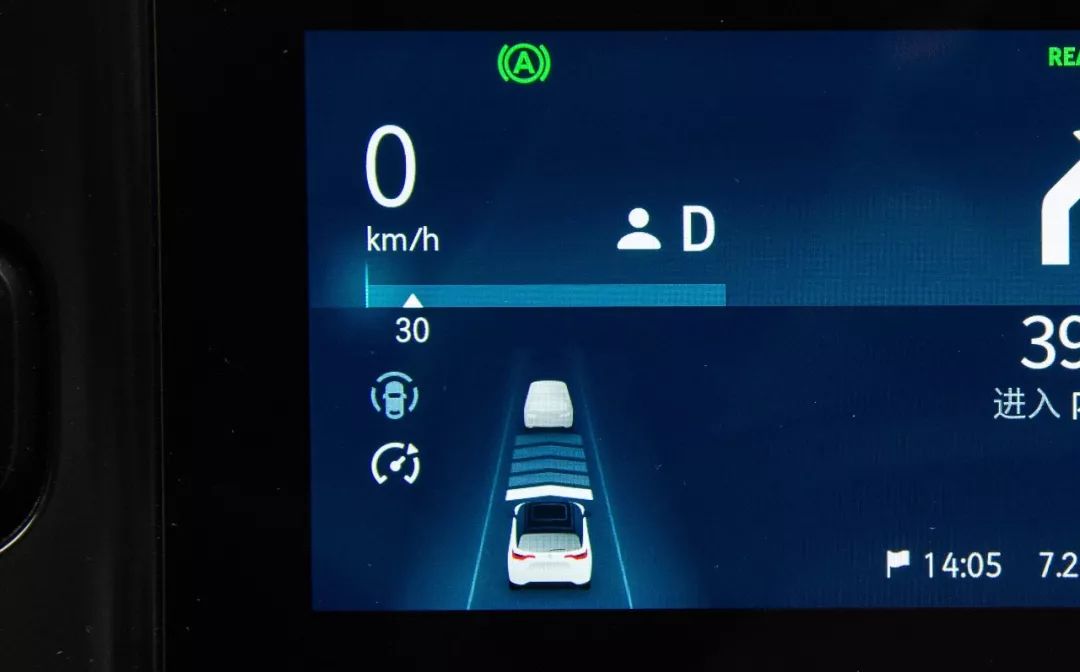
NIO’s ACC can achieve automatic follow-up in the entire speed range, and can automatically restart and catch up with the front car within 5 seconds after parking. If more than 5 seconds have elapsed, you need to lightly tap the accelerator or press SET+ to reactivate the ACC for automatic follow-up. The overall acceleration and deceleration control is smooth enough, and the following distance has 5 adjustable levels. After adjusting to the 1st level, the following distance is closer compared to other brands.
The entire driving process has no problem, but compared with other electric vehicles’ ACC, ES8’s deceleration is not achieved by electric braking, but by mechanical braking. This is relatively rare in electric vehicles, that is, the greater and more frequent the speed changes during high-speed driving, the greater the difference in energy consumption compared to using electric-braking ACC. This point has been criticized.
Static Article
Configuration, space, and luxury are ES8’s strengths in the static part, worth 16 out of the full 20 points.
Texture: Texture can be divided into two parts, one is the texture of the appearance, and the other is the texture of the interior.
Let’s start with the appearance. I believe everyone is familiar with ES8. When you walk to the side of ES8, it gives you a sense of luxury, which comes from two aspects: design and workmanship.
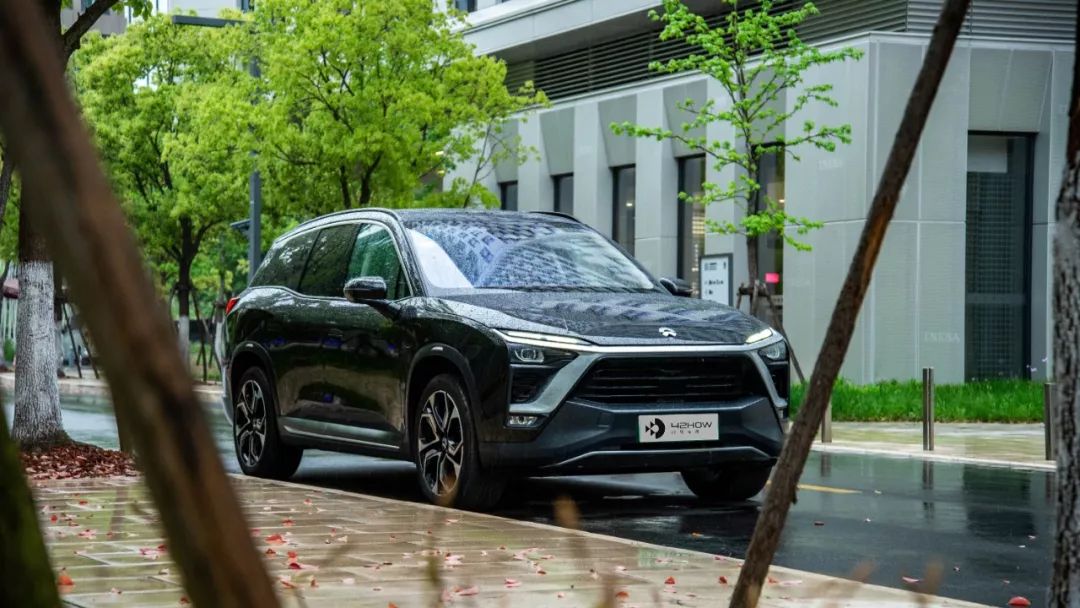
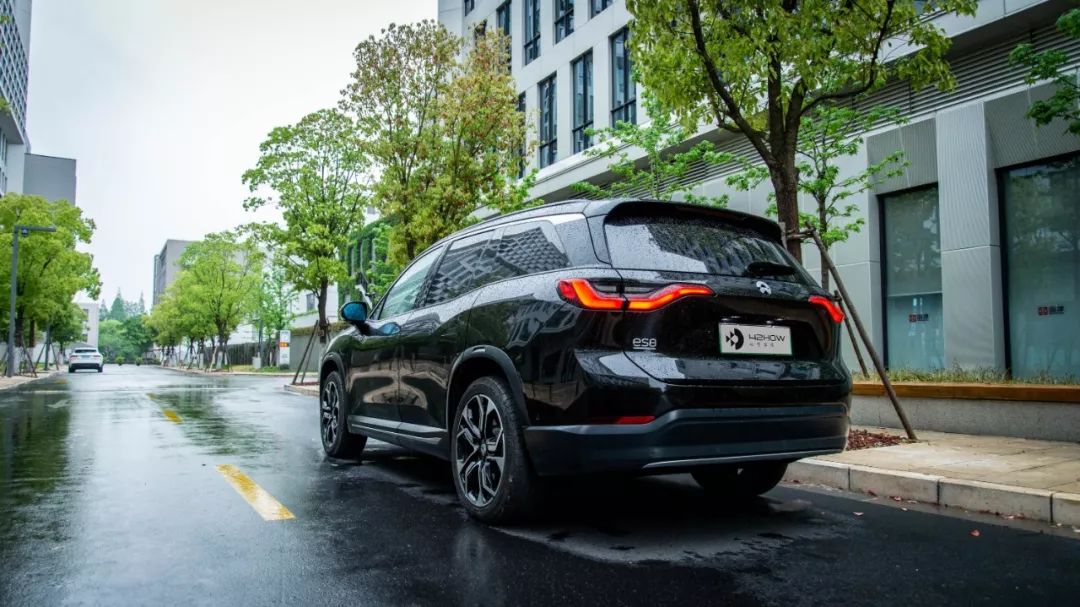 NIO’s design is unquestionable. Although some people think it’s ugly and others think it’s beautiful, it can’t be denied that it’s a well-designed car. Moreover, NIO has established its own family-style design language, which is very important for a new force in car manufacturing.
NIO’s design is unquestionable. Although some people think it’s ugly and others think it’s beautiful, it can’t be denied that it’s a well-designed car. Moreover, NIO has established its own family-style design language, which is very important for a new force in car manufacturing.
Although the ES8 is manufactured by JAC Motors, the factory that produces the ES8 is a new factory built jointly by NIO and JAC Motors. The quality of the product is also evident, with no problems with the seams of the exterior parts or the paint.
The texture of the interior is also excellent, with no sense of cheapness in the design.
The space for passengers and storage is also very large. Soft leather covers everything that can be touched, and the top-of-the-line ES8’s Nappa leather usage area reaches 17 square meters. The configuration is also very rich, and everything you can expect from a car at this level is included.
Seats: The front seats of the ES8 are very spacious, with delicate Nappa leather, ventilation, heating, massage, and electric lumbar support. The functions are very rich, but the lack of seat memory is not acceptable. In theory, this feature can be added through OTA, and we strongly recommend that NIO update it as soon as possible. The material filled in the seats are slightly hard, and due to their oversize, the wrapping is average.
The second-row seats are also very spacious and support 4-way adjustment of the front-back and backrest angles, with a wide range of adjustments available.However, there is an issue with the center seat of the second row: the cushion and backrest are both comparatively hard, making for a not particularly comfortable experience despite the ample space. While I won’t often be demanding in terms of comfort for the central position of the second row, the ES8 is after all a mid-sized seven-seater SUV, so the middle seat has some expectations to meet in terms of comfort.
But don’t worry, I didn’t forget about the queen’s seat. After all, the queen’s seat is one of the selling points of NIO.
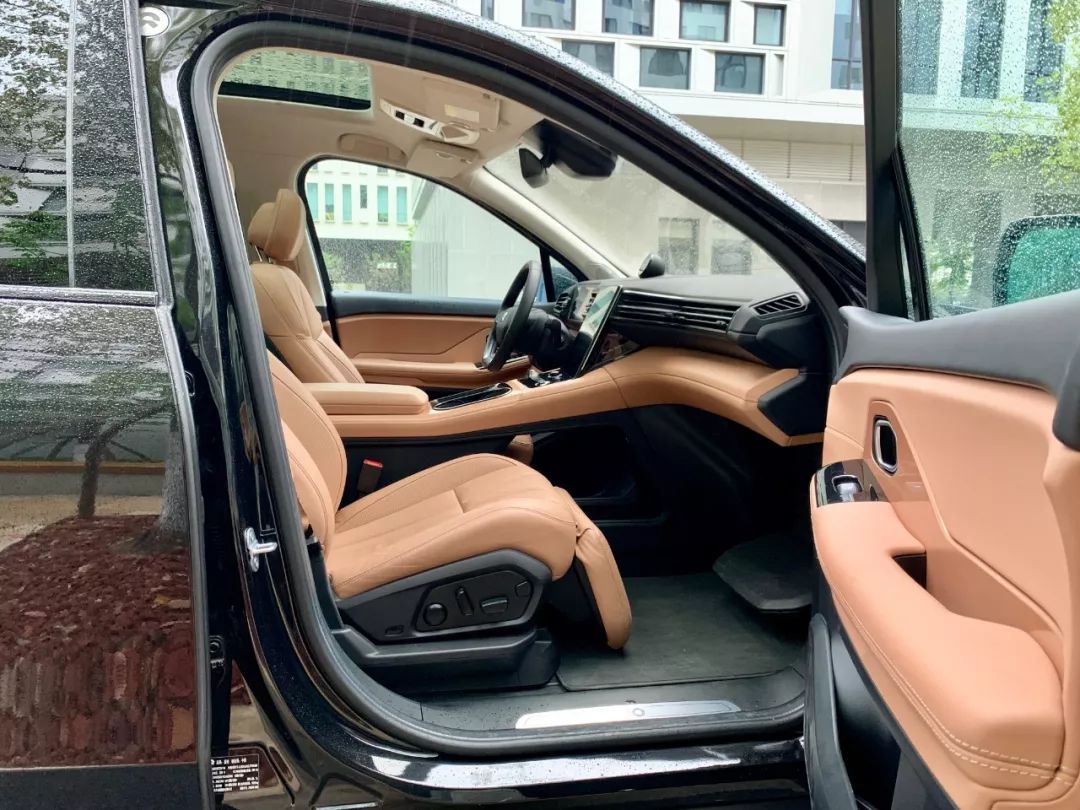
In order to create the queen’s seat, the ES8’s center console was pushed forward during design, and the glove box of the passenger seat was eliminated to make space for larger legroom. As for the seat itself, the queen’s seat has been equipped with a leg rest and foot pedal, while its back-and-forth adjustment range is extremely long. Both its space and comfortability are beyond doubt, although in my opinion the leg rest is already very comfortable and the foot pedal is somewhat superfluous, and it would be better off returning to a glove box.
Space: Space is also an area where the ES8 does extremely well. With a length of 5022 mm, a width of 1962 mm, a height of 1756 mm, and a wheelbase of 3010 mm, both the horizontal and vertical space have been greatly expanded. Additionally, the floor of the second row is completely flat, making for an extremely spacious interior.
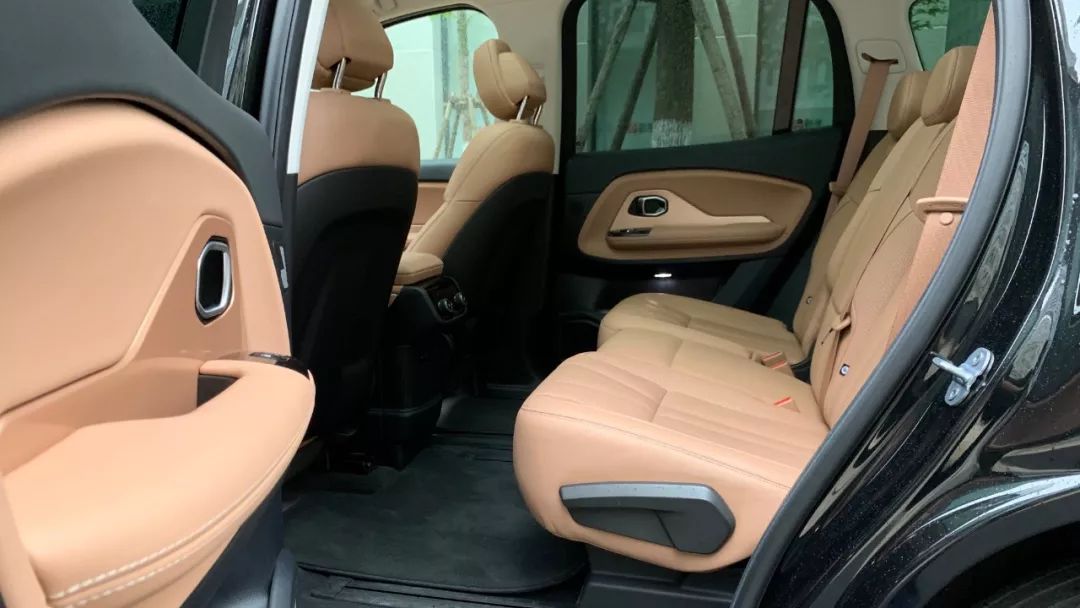
As for the third row, speaking from my 1.74-meter height, with the first and second rows adjusted to the appropriate seating positions for me, there is still plenty of room in the third row. Short trips in the third row are certainly no problem, but long trips can be uncomfortable. Additionally, child safety seats can be installed in the second and third rows of the ES8.
Storage space: With the third row of seats open, a 20-inch suitcase can be laid horizontally in the ES8’s trunk with room to spare, and there is also a large storage space under the floor.
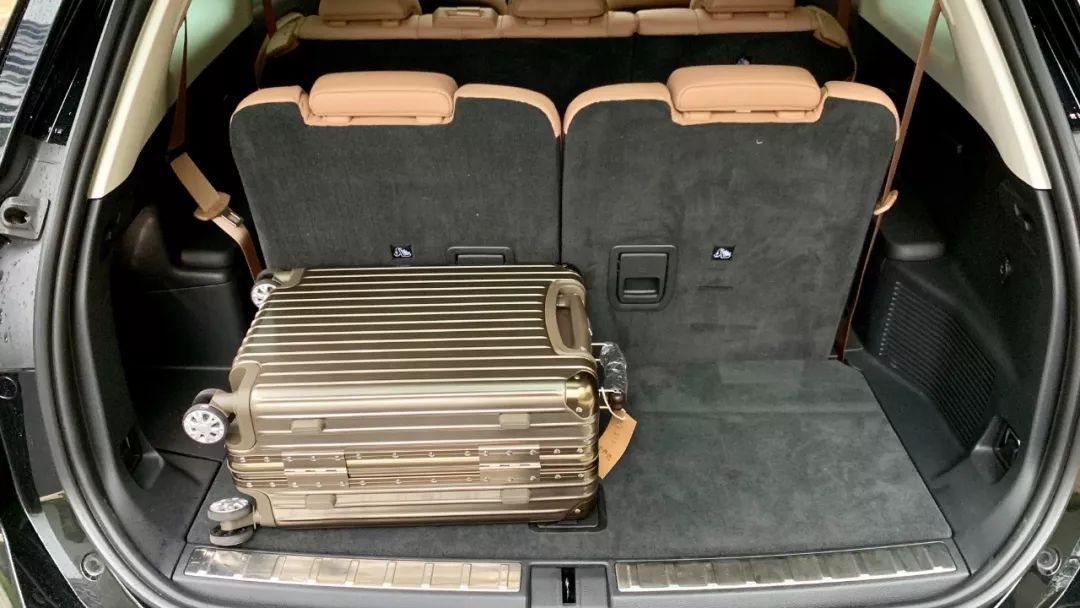
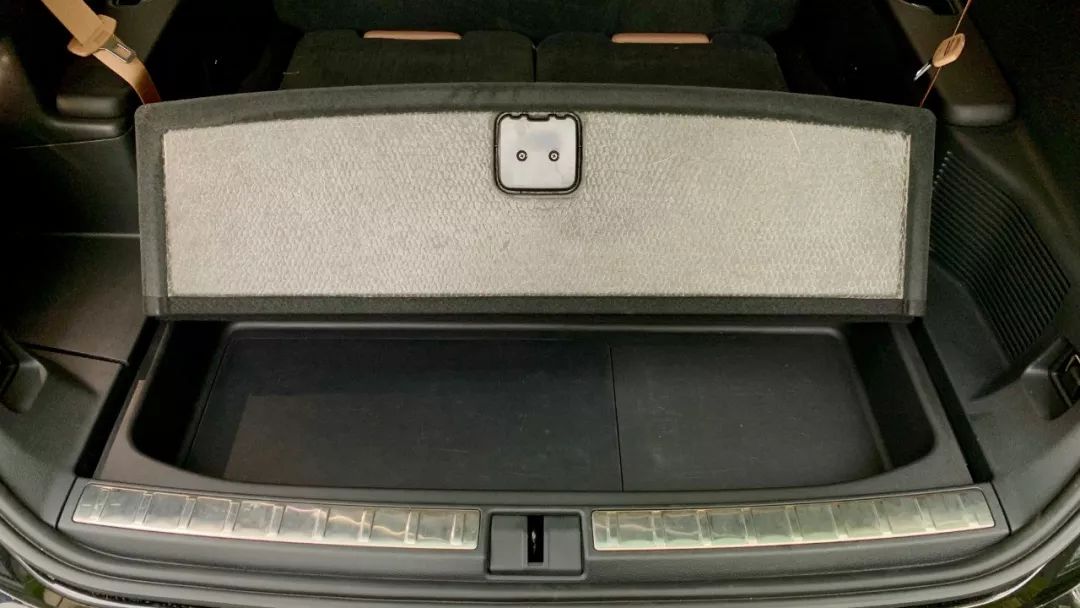 # NIO ES8 Test Drive Report
# NIO ES8 Test Drive Report
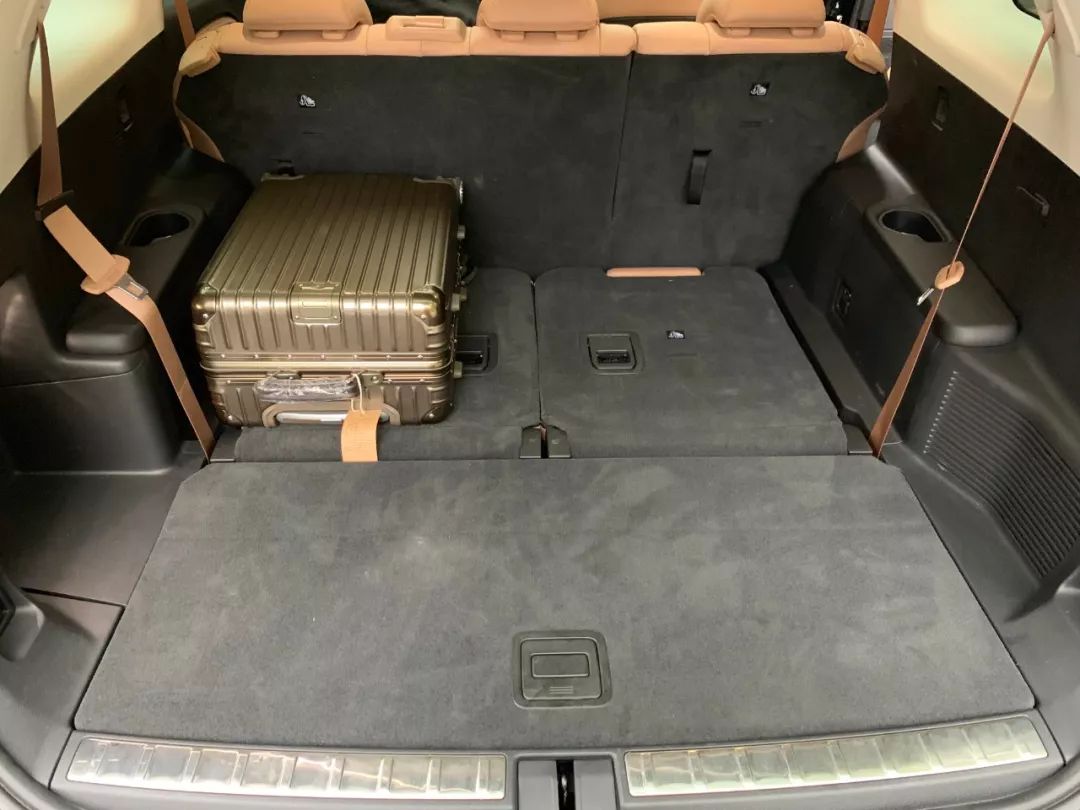
With the third row folded down, the trunk of ES8 is huge. If even the second row is also folded down, it is possible to sleep comfortably inside the car while looking at the stars through the panoramic sunroof.
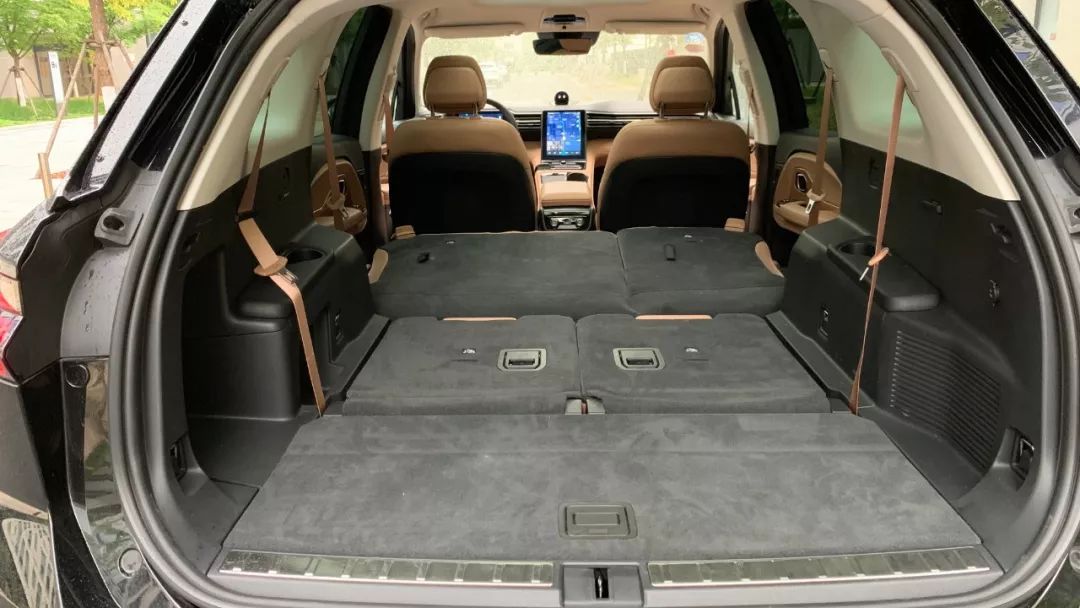
The storage space inside the car is also large and handy. There is a convenient storage space around the center console of the front row, a 50W wireless charging pad, a glove compartment, and two USB charging ports in each of the back rows.
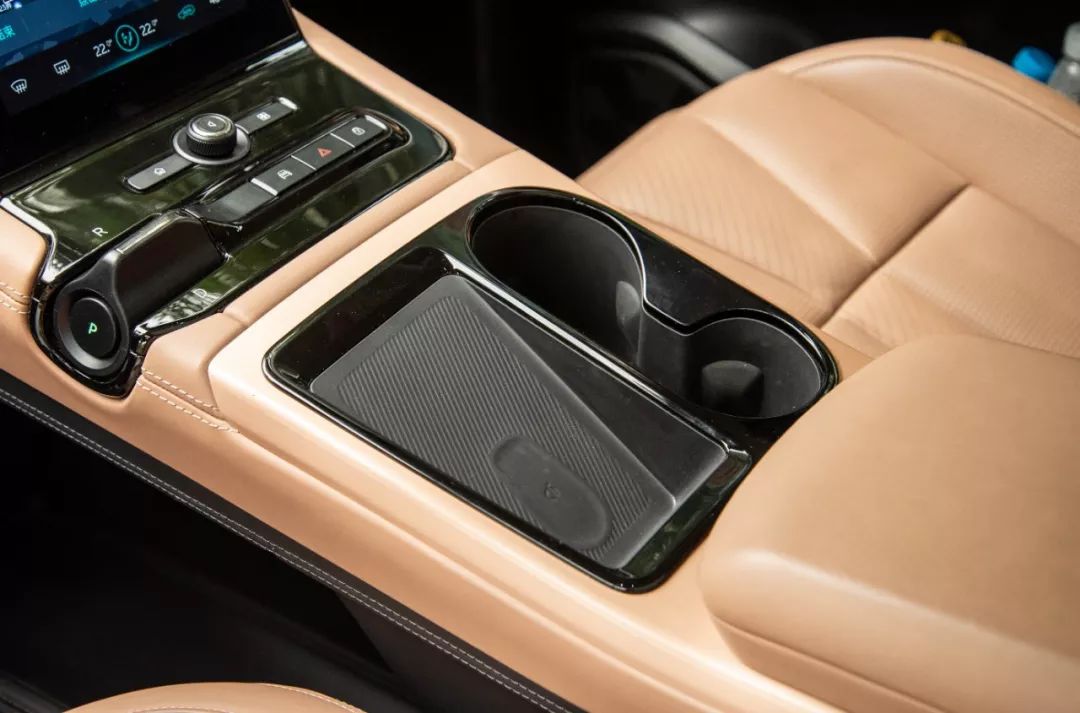
NVH of ES8 is outstanding. The overall noise control is very good when driving at medium to high speeds, and there is no abnormal noise generated even on bumpy roads.
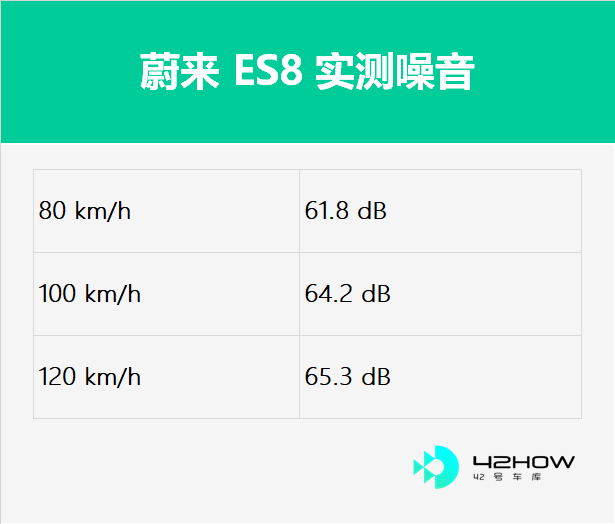
In addition, there are a total of 12 speakers throughout the car, which, although not branded, meet the expected level of sound quality for this type of vehicle.
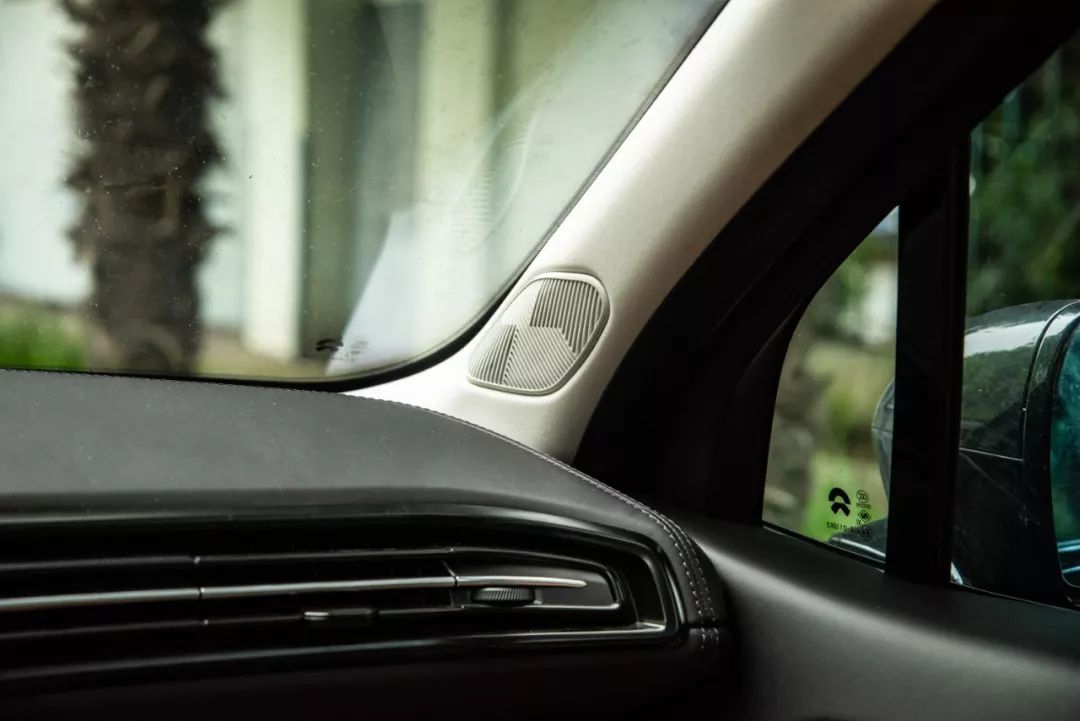
The above is the evaluation of the quality of the vehicle itself. However, besides the car, the service system is also one of NIO’s selling points.
Service
In practice, NIO’s one-click charging service almost achieves a seamless service. I placed an order on my phone, filled in the relevant location of the vehicle, and when I returned to the car, it was fully charged. The system automatically assigns a charging plan based on the remaining range of your car and its location. Currently, NIO’s charging plans are divided into two types:
First, when there is sufficient range remainingTranslated English Markdown Text:
NIO will dispatch mobile charging teams to your location based on your vehicle’s GPS coordinates to charge your car at the nearest charging station or battery swap station. The system will determine whether to charge or swap the battery. Car owners can view the charging location and vehicle driving route on the app, and the entire process will take about 2 hours. The estimated time will be provided on the app before ordering, which is very accurate.
Reasons why the process is almost unnoticeable:
- Firstly, NIO’s vehicle location is extremely accurate, so the mobile charging team can easily locate your car based on your vehicle’s GPS coordinates.
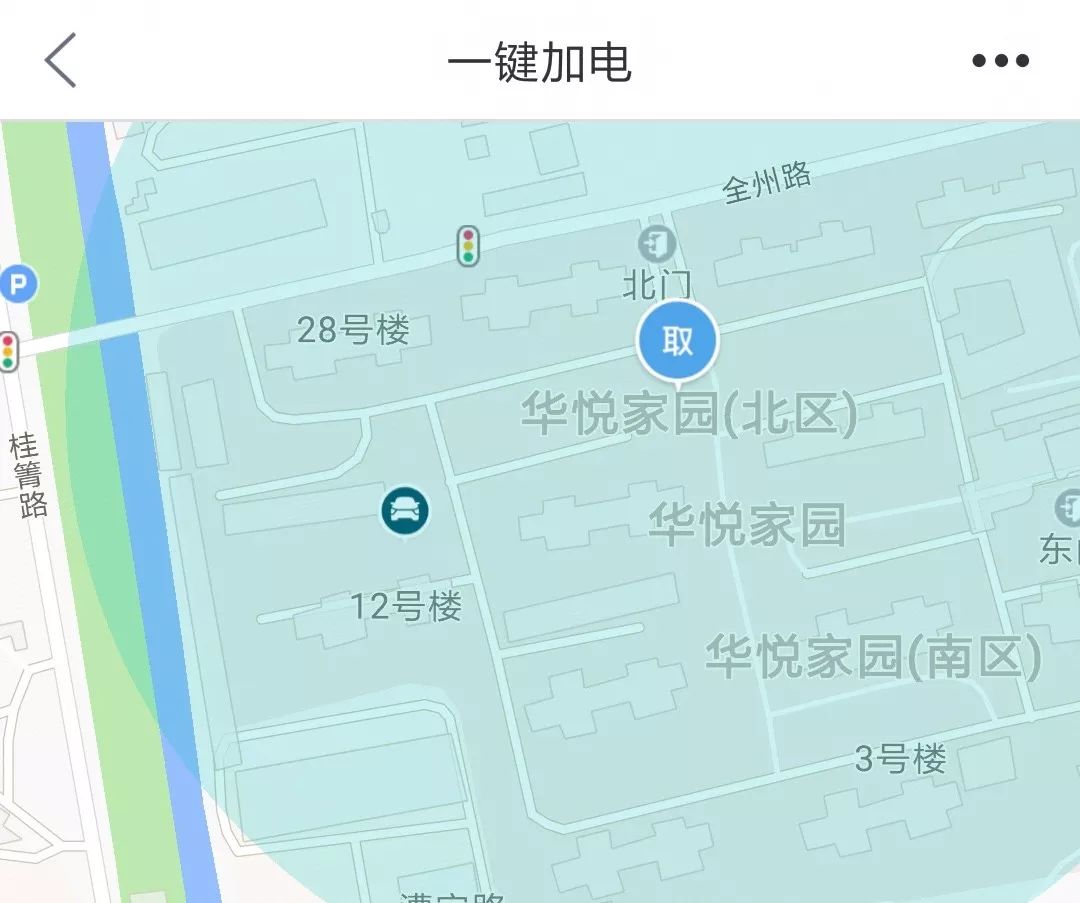
-
Secondly, the mobile charging team can open your car door via NFC key fob, so you do not need to hand over your key. Only after you have authorized the team’s key fob through the one-click charging feature, can they open your car door. There is no need to worry about security issues during other times.
-
Thirdly, after driving your car away, the mobile charging team will park their car back in your original parking spot. Therefore, there will be no change in your car’s position after charging. The only drawback is that you will need to manually turn on Bluetooth every time you get back in the car.
The second scenario is when your car’s remaining mileage is too low to make it to the next charging location.
NIO will dispatch a mobile charging truck to help you out. I have not experienced this scenario yet, so I can only briefly mention it here. I will not deliberately use up all the battery and depend on the mobile charging truck to help me, but it’s still an extremely reliable backup safety plan for any emergency situations.
As for the cost of one-click charging – it costs 180 yuan each time, 980 yuan per month, or 10,800 yuan per year. After purchasing the Power and Energy bundle, which includes 15 times of one-click charging and 1,000 kWh of free charging/swapping per month, I strongly recommend this to anyone who doesn’t have a home charger. 15 times per month equals once every two days, which should be enough for most people.
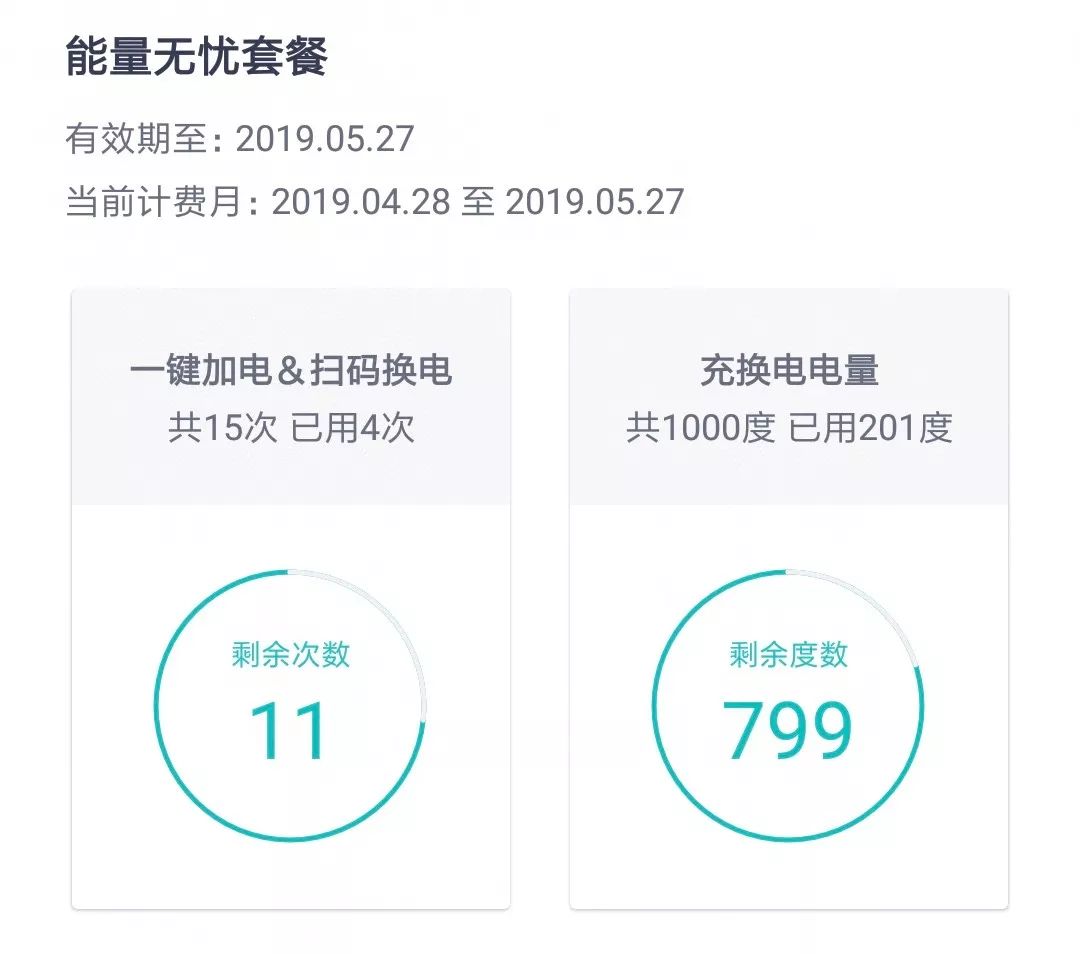
Now that I have talked about “Power and Energy”, let’s move onto “Service and Maintenance”.
NIO’s Service and Maintenance package is another spotlight of its service offerings. The cost ranges from approximately 13,800 to 14,800 yuan per year depending on the vehicle model.
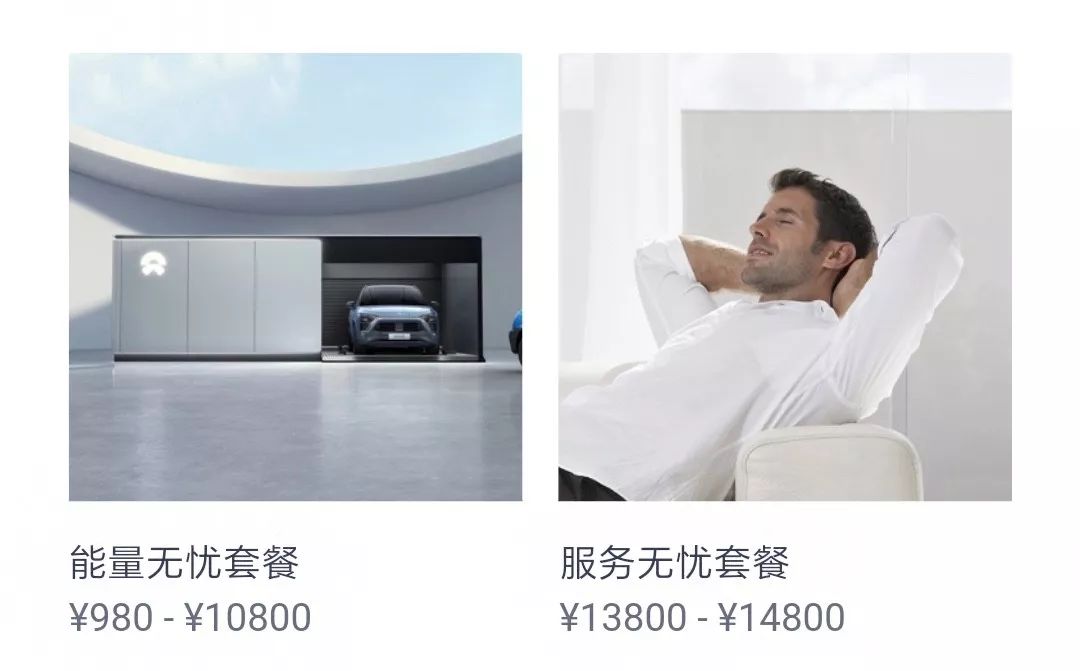 Don’t rush to call it expensive- this service of worry-free package from NIO includes the price of one year’s vehicle insurance as well as a large number of auxiliary services, which I won’t go into details of here. Take a look at the picture below:
Don’t rush to call it expensive- this service of worry-free package from NIO includes the price of one year’s vehicle insurance as well as a large number of auxiliary services, which I won’t go into details of here. Take a look at the picture below:
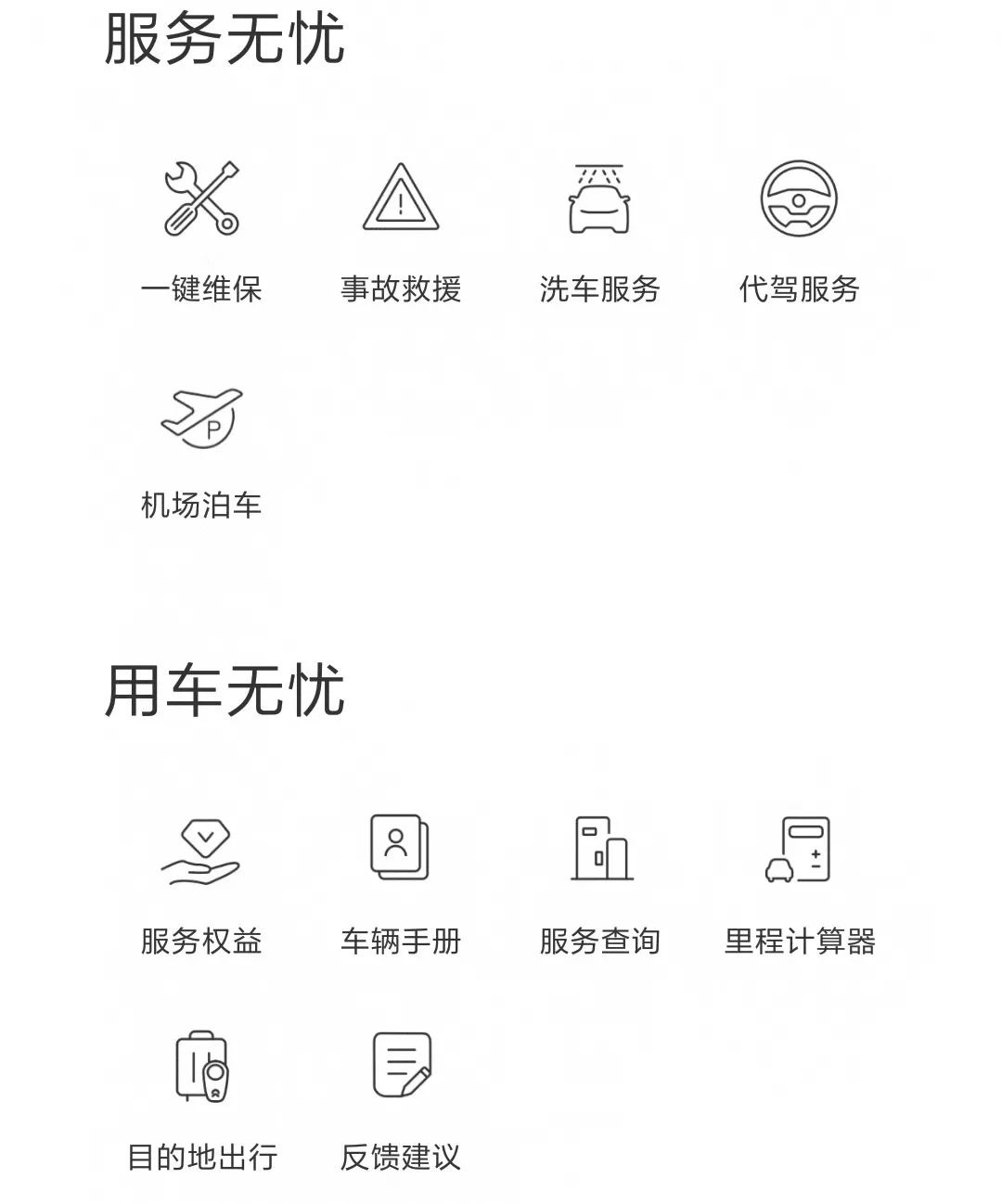
In summary, NIO’s services are almost unobtrusive, saving vehicle owners a lot of troubles when using their cars.
NIO App
NIO is very proud of the number of active users in its app community, and there are many high-quality customized products in the app store. However, these two points are not our focus. Let’s take a closer look at the functions of the app.
Vehicle control: You can see the real-time location of your vehicle and the current remaining range on the NIO app. You can also turn on/off the doors, air conditioning, and other functions remotely through the app. It takes about 2-3 seconds for the instructions to be executed, which is no different from most other remotely controlled vehicles, but there are some very useful features in the NIO app.
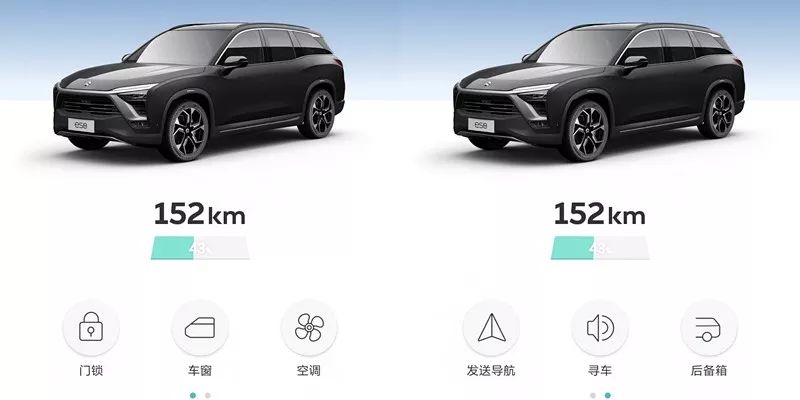
Send navigation to your vehicle: More and more vehicles are able to achieve this function, but the overall smoothness of NIO is very good, and this is a very useful feature. I also look forward to seeing more vehicles capable of this function.
Charging map: The NIO app also has a charging map function, which integrates the vast majority of charging stations on the market. You can also see the specific location, type, quantity, cost, etc. of the charging stations. In addition, after entering the departure and destination in the charging map, the system will generate a detailed route and charging stops. As far as I know, many other electric car owners of other brands also use NIO’s charging map to find stations for charging.
Function Integration: Another great point that satisfies me is that NIO integrates all the services related to their worry-free package into the app, so car owners don’t need to download other apps separately when using these services. Just one NIO app can take care of many services such as car washing, valet parking, airport pick-up, and more. It’s really convenient to use.
A summary
After this long test, I don’t think the ES8 is as bad as the public opinion suggests. But in terms of the car’s positioning, its range is indeed limited, the operation logic of the car machine and the display of the instrument content still have room for improvement, and the suspension tuning is not comfortable enough on bumpy roads.But the acceleration performance is outstanding. The configuration is beyond the level of its peers, and the space also reaches the level of a large 7-seater SUV. In addition, the luxury of the interior is also very good. NIO’s one-click charging service system does solve the problem of electric vehicle power replenishment to a certain extent.
Looking at the market for pure electric vehicles, there are few models in the 400,000 to 600,000 RMB price range. NIO has captured its own user base through precise positioning and decent product power, but if they want to survive in this highly competitive industry, NIO’s products must be recognized by more people.
So the next question is: Is the ES6 better than the ES8?
What are the advantages and challenges of NIO’s battery upgrade service?
We test drove the NIO ES6 on the street and track | Biggest Unboxing


This article is a translation by ChatGPT of a Chinese report from 42HOW. If you have any questions about it, please email bd@42how.com.
